Practical Boat Owner
- Digital edition


Best trailer sailboats: Our trailer sailing expert offers his recommendations
- Colin Haines
- March 28, 2022
PBO reader Paul Adamson wants to know what are the best trailer sailboats. Our trailer sailing expert Colin Haines has this advice…

Paul Adamson wonders if a Beneteau First 21.7 like this is the ideal trailer-sailer for him. Photo: David Harding
Paul Adamson from the Isle of Man, writes: “My wife and I are looking to buy a trailer sailboat, mainly for coastal cruising with an overnight before returning to berth.
“We have room to store over winter and so are looking forward to all those upsides that trailer sailing offers.
“My research so far is leading me to a Beneteau First 21.7. Is there anything else out there that I should also seriously consider as a trailer sailboat?”
PBO trailer sailing expert Colin Haines replies: “These days the limitations of getting a boat to the water are clearly defined.
“Obviously, your driving licence defines your limits with regards to weight you’re allowed to be in control of.
“The maximum weight of trailer that a car can pull is defined by the car’s VIN plate and the maximum allowable weight on a single axle is 1,800kg.
“Double axle trailers can carry more weight but are effectively impossible to turn round by muscle power alone when manoeuvring. The 3,500kg limit of combined car and trailer weight may also apply.
Article continues below…
Trailer-sailing? Tow your boat safely
Simple stop and check technique

What is a lugger? And why they make great trailer-sailers – answered!
Compulsive boat owner Clive Marsh explains why little luggers make perfect trailer-sailers
“The internet tells me the official weight of a Beneteau First 21.7 is 1,245 kg, but this will be the minimum. Reality may well see the boat weighing more.
“Steel-built trailers typically weigh about 40% of the weight of the boat they carry, suggesting you’re looking at towing something like 1,750kg, perilously close to the 1,800kg limit for a single axle trailer.
“However, having personally towed a similar weight for many thousands of miles, provided your rig is well set up and you take your time it presents little to worry about if the trailer’s brakes are better than adequate.
“Launching and recovering a heavy boat depends on the trailer’s design. Submersion launching will lead to problems with rusting trailer wheel bearings. Sealed bearings keep grease in but won’t keep water out – they can rust after a single submersion.

Quite large yachts can be successfully trailed and sailed with the right tow vehicle and trailer combination. This is a Swallow Yachts Bay Cruiser 26
“One solution is to carry the boat on a launching trolley resting on the trailer, adding weight to be towed down the road. The other is some form of break-back trailer that pivots in the middle.
“Getting the trailer’s wheels wet to allow the boat to be launched into deeper water is not a problem provided the water level does not reach the bearings.
“Trailer brakes do not prevent the trailer from running backwards down a slipway, so the tow vehicle needs a very effective handbrake.
“The Beneteau First 21.7 is ‘unsinkable’ but everything has a price. In this case, being unsinkable the boat is effectively two boats, one inside the other with foam in between.
“The inner ‘boat’ is therefore smaller and there’ll be a lack of stowing spaces compared with similar sized single-skin boats. This I know because much of my trail-sailing was done with an unsinkable Etap 22i .
“The adverts don’t mention thermal insulation, but it is an important consideration. One Easter on the Norfolk Broads we were warm enough in the cabin when we woke up to be surprised to see an inch or so of snow on the decks.
“I wouldn’t limit your search to a single trailer sailboat at this stage. Instead, I suggest you prepare a list of desirable features and then look for the best trailer sailboats that tick as many boxes as possible.
“There may be some mileage in the idea of buying your first trailer sailboat knowing that it’s not perfect, and with the full intention of sailing it for two years and then selling it.
“By then, you may have the same tick-list, but the priorities for you and your wife will be very, very, different. What you actually end up buying will then depend on what is for sale at the time. As ever, the final choice will be a compromise.
“The benefit of a trailer sailboat, of course, is that it opens up a whole new world of cruising grounds. A Spring Bank Holiday on Scotland ’s west coast can be followed by a summer holiday cruise of Brittany’s Gulf of Morbihan. I’ve done that, and during the same year spent Easter on the Norfolk Broads.
“If you choose a trailer sailboat that’s easy to launch and rig the mast, then when fair winds coincide with a weekend, the whim to spend a night anchored somewhere sheltered can be turned into a reality.”
Why not subscribe today?
This feature appeared in the April 2022 edition of Practical Boat Owner . For more articles like this, including DIY, money-saving advice, great boat projects, expert tips and ways to improve your boat’s performance, take out a magazine subscription to Britain’s best-selling boating magazine.
Subscribe, or make a gift for someone else, and you’ll always save at least 30% compared to newsstand prices.
See the latest PBO subscription deals on magazinesdirect.com

9 Best Trailerable Sailboats

Last Updated by
Daniel Wade
December 28, 2023
Sailing is an excellent activity for the weekends, especially in remote mountain lakes or sheltered waterways. The United States is full of small isolated waterways, inland lakes, and rivers—which make the perfect environment for an adventure in a small sailboat .
Unfortunately, many people are put off by the idea of owning a sailboat due to the associated docking and maintenance fees. Weekend sailors often don’t want to pay for a long-term slip, and there’s no question that the added expense can be a pain.
Luckily, you don’t have to permanently dock a sailboat to enjoy this great pastime.
Instead of docking a large boat, you can purchase a small trailerable sailboat. A trailerable sailboat is a perfect option for part-time sailors and people with busy lives. Trailer sailors are some of the most popular boats in the country, and they’re not limited to light winds and calm seas. Many trailerable sailboats have made some impressive passages both offshore and coastal. In this article, we’ll go over some of the top new and used trailerable sailboats that you can purchase today.
Table of contents
Best Trailerable Sailboats
1) west wight potter 15.
{{boat-info="/boats/west-wight-potter-15"}}
The West Wight Potter 15 is perhaps one of the most capable 15-foot sailboats around. This neat little vessel is as seaworthy as it is easy to handle, and it’s a great choice for all kinds of cruising adventures.
The West Wight Potter 15 is a 15-foot sloop with an aluminum mast and tiller. This tiny boat also features a small cabin, which has ideal sleeping accommodations for a cruising couple. The cabin itself is spartan compared to its larger relatives, but it’s the perfect design for the minimalist cruiser.
This small sailboat is easily trailerable and can be stored in some garages with relative ease. The West Wight Potter 15 is ideal for inland and coastal waters and sets up (and takes down) fast with minimal fuss. Don’t let the small design fool you—this craft is surprisingly seaworthy.
The West Wight Potter 15 has an impressive cruising record, including a trip from England to Sweden in the brutal North Atlantic. The West Wight Potter 15 can be purchased new from International Marine, and thousands of craft are in circulation already.
2) West Wight Potter 19
{{boat-info="/boats/west-wight-potter-19"}}
We thought it fitting to include the Potter 15’s big brother, the West Wight Potter 19, on this list of the best trailerable sailboats . West Wight Potter boats are well known for their robust design and easy handling, and the Potter 19 is no exception.
The West Wight Potter 19 boasts the seaworthiness and ease-of-handling offered by its little brother, with the benefit of greater sailing comfort and cabin accommodations. This 19-foot sailboat is constructed of fiberglass. The hull contains a liberal amount of positive flotation, which makes the boat practically unsinkable.
The cabin features generous accommodations for a boat of its size, featuring space for a vee-berth, a small stove, a sink, and a portable head. Additionally, the West Wight Potter 19’s cabin can be wired for electricity from the factory, further increasing the level of comfort in this capable trailer sailor.
Like its smaller alternative, the West Wight Potter 19 has a history of some impressive cruises. An individual sailed this craft thousands of nautical miles from California to Hawaii —a single-handed voyage usually reserved for boats twice its size.
That’s not to say that the Potter 19 is a purpose-built long-haul sailboat. This design is ideal for larger lakes, rivers, and coastal cruising. However, the design has demonstrated toughness and seaworthiness rarely found in smaller boats.
The Potter 19, like the Potter 15, is a centerboard craft. This sailboat is available new from International Marine and offers a wide range of options packages and upgrades.
3) Newport 27
{{boat-info="/boats/capital-yachts-newport-27"}}
The Newport 27 is a massive step-up in size and amenities compared to the other boats on this list so far. This comfortable trailerable sailboat originated in 1971—at the height of the fiberglass boat boom. The Newport 27 measures 27-feet in length and feature a flush-deck design similar to the famous Cal 20.
This sailboat, despite its trailerable size and weight, features surprisingly good handling characteristics and generous accommodations. A full 6-feet of standing headroom is available in the cabin, making this boat exceedingly comfortable for longer journeys.
This sailboat is an excellent choice for the trailer sailing sailor who dreams of longer journeys but spends much of the time just hopping around local ports.
Despite its modest size and weight, the design of this small sailboat is proven. Many people sail them long distances and enjoy the quick handling characteristics of its design.
The Newport 27 is a true pocket cruiser, if not slightly larger than most. The Newport 27 isn’t produced anymore, but there is a healthy second-hand market for the boat.
4) Cape Dory 28
{{boat-info="/boats/cape-dory-28"}}
The Cape Dory 28 is a legendary Carl Alberg design known for its commodious living spaces and well-rounded performance both offshore and inland. This spacious little cruiser has the styling and capability of many larger boats, featuring traditional styling and generous amounts of varnished teak and brass. This cozy boat is a great choice for traditionalist sailors.
The Cape Dory 28 features a proven, simple, and robust rig, and it functions gracefully in a variety of conditions. While a 28’ sailboat is hardly considered trailerable by many, it can certainly be hauled-out and transported with relative ease. This is the kind of sailboat that’s just as happy in the boatyard or a permanent mooring.
The Cape Dory 28 offers attractive features for long-haul voyages, plus ease-of-handling and quickness that is necessary for tighter coastal waters. The Cape Dory 28 is ideal for salt-water cruising, though it’s a bit large for small lakes and narrow rivers.
This is certainly not a shoal-draft cruiser—with a draft of 4-feet, it's primarily at home in the water.
5) Islander 24
{{boat-info="/boats/islander-24"}}
The Islander 24 is a common fiberglass classic that makes an ideal trailer sailing setup. This 24-foot fiberglass boat features a robust design and ease-of-maintenance rarely found on boats with similar capabilities.
The design has been around for over 40 years, and it’s served weekender and cruising sailor alike. The Islander 24 is a well-rounded cruising vessel with a spacious cabin for two (or more). The cabin features a forward vee berth, space for a head, and tables for a sink, stove, or navigation.
The boat is single-handed with ease, and the rig is simple enough to be stowed without too much hassle. The Islander 24 is a relatively common trailer sailor, though many owners leave it in the water.
A vessel of this size is ideal for cruising coastal waters, though some sailors have attempted longer voyages in this vessel. The Islander 24 is available on the used market all over the country.
6) Contessa 26
{{boat-info="/boats/contessa-26"}}
The Contessa 26 is an excellent classic trailerable sailboat. Don’t let its modest size fool you—this cruising craft has a long-standing reputation for seaworthiness. The Contessa 26 is a fiberglass boat that debuted in 1965 and has since earned a bit of a cult following.
These rather innocuous looking crafts are as fun and capable as they are easy to handle. The boat features a spacious cabin, comfortable cockpit, and plenty of available cruising upgrades. The rig is well-built and resembles the rig of a much larger boat.
The Contessa 26 is an ideal pocket cruising setup for a moderately experienced sailor. The vessel has a narrow beam, which contributes to heeling. The boat is known to heel rather violently, but it stiffens up shortly after and becomes a joy to sail.
A boat like this knows its capabilities and is sure to impress anyone. The Contessa 26 is a safe, hardy, and comfortable cruising boat for minimalists, and one of the best tailorable sailboats in the mid to large-size category.
This boat is a little harder to come by than many other vessels on this list, as around 300 were built. However, if you’re lucky enough to locate one on the used market, it’s definitely worth considering. Contessa built a fine boat, and the Contessa 26 meets the standard with confidence.
7) Hunter 27
{{boat-info="/boats/hunter-27"}}
If you’ve made it this far down the list, you’re probably surprised that the Hunter 27 hasn’t come up yet. This famous little boat has quite a reputation and happens to be one of the most popular modern trailerable cruisers available.
The Hunter 27 isn’t a traditionalist’s dream, but it offers the modern amenities and capabilities you’d expect from Hunter. This capable little sailboat has the handling characteristics of a truly seaworthy boat and manages well in all kinds of conditions.
The Hunter 27 has a reputation for amazing durability, and the design is sound from keel to masthead. Now, let’s get into some of the features that make the Hunter 27 a very attractive option. The Hunter 27 is a purpose-built small cruising vessel, but the accommodations appear to be a shrunken version of a boat 10 feet longer.
Down below, the Hunter 27 features a full galley, head, a full standing shower, berths, and generous storage space. The Hunter 27 is a truly livable trailer sailor, featuring accommodations that make it suitable for extended cruising or even living aboard. The salon features over 6 feet of standing headroom, with plenty of seating and counter space throughout.
The rig is sturdy and easy to handle. And remember, the Hunter 27 is still a trailer sailor. The boat features a shoal draft of under 4-feet and a displacement of less than 8,000 pounds. The Hunter 27 is available used, and this boat is still produced and available brand-new by Marlow-Hunter.
{{boat-info="/boats/cal-20"}}
How could we forget the little Cal 20? We didn’t—and it’s certainly worth including the famous Trans-Pac underdog on this list. The Cal 20 is reminiscent of the glory days of fiberglass sailing in the 1960s and 1970s.
This flush-deck racer is a fantastic trailer cruiser for anyone wanting big-boat handling and speed in a compact package. The accommodations on this boat leave something to be desired, but many people find them cozy and acceptable.
The cabin features sitting headroom and a berth, along with small tables for a stove or sink. The Cal 20 has a history of impressive voyages and was a popular choice for daring sailors on long offshore journeys. However, the boat is designed to be quick, safe, and fun on inland passages and coastal cruises.
The Cal 20 is common on the used market and makes a great entry-level cabin sailboat. The Cal 20 features an enormous cockpit, making it ideal for a day on the bay with friends or family.
The boat is easy to handle, and upgrades abound. The Cal 20 is a great little sailboat with a fun history and a massive fan base. This stout little yacht makes an excellent weekender too, and the cabin makes overnighting comfortable.
9) Pacific Seacraft Flicka 20
{{boat-info="/boats/pacific-seacraft-flicka-20"}}
One of the most legendary small trailerable cruisers is the full-keel Pacific Seacraft Flicka 20. A limited number of these boats were produced by Pacific Seacraft during the 20th century, and they have a reputation for incredible seaworthiness and long-range voyaging.
These sailboats have the hull shape of boats twice their size, with a long, deep, full keel running the length of the hull. The boat can handle some serious offshore cruising and features the capabilities of other full-keel sailboats.
The Pacific Seacraft Flicka 20 is an amazing find on the used market, as owners tend to cling to them due to their incredible characteristics. There aren’t many trailerable offshore cruisers available, which is because it’s not easy to design a small boat with offshore capabilities.
However, Pacific Seacraft did just that and built one incredible trailer sailor. This vessel is not really designed for shallow lakes and rivers.
The Flicka 20 is known to be a truly seaworthy ocean-going sailboat, which happens to be small enough to fit on an average-sized boat trailer.
Wherever you choose to sail, a trailerable sailboat is often a great choice. The boats listed here are by no means the only options—in fact, there are dozens of excellent trailerable sailboat models on the market. If you enjoy sailing but want to avoid the hassle of a permanent mooring, or if you travel to sail, a trailer sailor is a great choice.
Many sailors pick trailerable sailboats to sail multiple oceans. Many people would agree that it’s a lot more practical to haul your boat from the Pacific to the Atlantic, especially when the alternative option is the Panama Canal .
A trailerable sailboat can give you access to a multitude of sailing adventures—the lake one weekend, the coast the next, and perhaps an offshore voyage or island hopping in the delta.
And with this list of the best trailerable sailboats, you can find the boat that fits your needs (and your budget) and hit the water in no time.
Related Articles
I've personally had thousands of questions about sailing and sailboats over the years. As I learn and experience sailing, and the community, I share the answers that work and make sense to me, here on Life of Sailing.
by this author
Best Sailboats
Most Recent

What Does "Sailing By The Lee" Mean?
October 3, 2023

The Best Sailing Schools And Programs: Reviews & Ratings
September 26, 2023
Important Legal Info
Lifeofsailing.com is a participant in the Amazon Services LLC Associates Program, an affiliate advertising program designed to provide a means for sites to earn advertising fees by advertising and linking to Amazon. This site also participates in other affiliate programs and is compensated for referring traffic and business to these companies.
Similar Posts

Affordable Sailboats You Can Build at Home
September 13, 2023

Best Small Sailboats With Standing Headroom

Best Bluewater Sailboats Under $50K
Popular posts.

Best Liveaboard Catamaran Sailboats

Can a Novice Sail Around the World?
Elizabeth O'Malley
June 15, 2022

4 Best Electric Outboard Motors

How Long Did It Take The Vikings To Sail To England?

10 Best Sailboat Brands (And Why)
December 20, 2023

7 Best Places To Liveaboard A Sailboat
Get the best sailing content.
Top Rated Posts
Lifeofsailing.com is a participant in the Amazon Services LLC Associates Program, an affiliate advertising program designed to provide a means for sites to earn advertising fees by advertising and linking to Amazon. This site also participates in other affiliate programs and is compensated for referring traffic and business to these companies. (866) 342-SAIL
© 2024 Life of Sailing Email: [email protected] Address: 11816 Inwood Rd #3024 Dallas, TX 75244 Disclaimer Privacy Policy

- Find my AS Number
- Clubs & Classes
- Training Training Training Discover Sailing Centres Our Programs Safety & Sea Survival e-Learning Courses Instructors Coaches Training in Focus - Live Events RYA Programs International Certificate of Competence Duke of Edinburgh's International Award Training in Focus
- Officials Officials Officials All Officiating Officials Courses Accreditation and Re-accreditation Officials Resources Racing Rules & Appeals Race Officials Committee Equipment Auditors Para Classifiers Find an Official or Assessor
- Safety Safety Safety Safety Code Induction- Online Course Safety information notices Risk & Incident Management Get Safety Support Equipment Auditing Special Regulations Special Regs Interpretations Safety Committees Major Incident Reports Maritime Regulatory Authorities Safety in Focus
- Ratings & Measurement Ratings & Measurement Ratings & Measurement Measurement Certificates Sail Numbers IRC Ratings ORC Ratings IRC Forms
- Rules Rules Rules Racing Rules of Sailing Rules Specialist Group Opinions Appeals Appeal Decisions Disciplinary- Misconduct (RRS 69) Jury Approvals Officials Resources World Sailing Documents Rules in Focus
CBH Rating System
Australian class based handicap (cbh) rating system, for trailable yachts and sports boats.
Australian Sailing undertook a review of the role of the National Trailable Yacht & Sports Boat Committee in 2020
As part of this process, a survey of stakeholders was conducted which attracted over 470 responses. The feedback from this survey resulted in some small changes to the handicapping model, as well as the procedures for managing ratings applications.
The Class Based Handicap (CBH) formula has now been updated to align it with World Sailing’s Equipment Rules definitions and remedy some other previously identified issues. This change will ensure the rating is more inclusive, allowing a wider range of Trailable Yacht and Sports Boat Classes access to a CBH rating.
As a result of the changes to the model and definitions the Trailable Yacht & Sports Boat Rule has been amended to reflect these changes and has now become the CBH Rating System.
In addition, the National Committee has been disbanded and the CBH ratings function will be administered internally by Australian Sailing staff. Australian Sailing will also coordinate the hosting of the National Championships, in line with the way other Australian Sailing events are managed.
The Rating System is intended to:
• Provide a National System for even and fair racing on handicap in a mixed fleet of Trailable Yachts and / or Sports Boats • Ensure transparency across the rating system • Allow Trailable Yacht and Sports Boat owners to gain a new CBH at any time of the year • Support Australian Sailing in its work to promote Trailable Yacht and Sports Boat racing activities within the states and territories and at national level.
Key Points:
• The Rating System only requires boat measurements, not performance data. • The CBH rating list will be published online and updated regularly and new boats are added. • The CBH formula will be reviewed annually and any amendments will be posted from time to time.
CBH Rating System document
NEW APPLICATIONS and AMENDMENTS:
To declare your boat or your class measurements you will need to upload the Measurement Input Sheet that you can be downloaded here
Measurements input sheet Rev J-05
- If you are a Class R epresentative and you want to declare your Class measurements to get a CBH rating, you can do it online Apply
- The measurement manual for CBH is available here.
- The light ship requirements for weighing are explained here .
If you are the owner of One of A Kind boat that can't fit in any Class (either because it has been modified or because it's a one off design) you can apply online for a new CBH rating or to amend an exsisting certificate here.. Apply or Amend CBH a fee of $100 applies for each application.
CBH RATING LIST:
The CBH rating list will be updated on a day to day basis with new measurements and new Classes as they come to hand. The CBH formula will be reviewed once a year on the 1st of July. The ratings are presented as a PDF any boat with a rating of 1 has insufficient date at the time of publishing this report.
The rating formula is reviewed once a year and a new list is issued each year on the 1st of August.
The Australian Sailing Rating office is still looking for some Class measurements. If you can provide measurements for a Class that is not listed in the new rating list, please contact the Rating Office, your help will be much appreciated:
(02) 9170 6917
Software Update: (2nd of Sept 2022)
The calculation of effective length has been updated resulting in rating changes. (120822)
Non-Spinnaker CBH Calculation altered generally increasing the NSCBH value 2% to 3% (020922)
The CBH rating needs to be measured by an Australian Sailing Accredited Measurer. You will find the list of Measurers in Australia here .
- Can I use both the old and the new rating system in one event? No, the new rating is a different formula than the old one.
- My boat/class is not in the new CBH rating list, how can I add it? To add a boat or a Class to the CBH list you need to contact the Ratings Office ( [email protected] ) or follow the steps found in the “NEW APPLICATION” paragraph at the top of the web page.
- Why is the CBH rating formula not published? The CBH rating formula is not published to prevent the optimisation of a boat to “beat” the rating. The aim of the CBH is to be a simple rating system, cheap and easy to use. The aim of this rating is not to encourage boat modification outside of Class Rules.
- What does it cost to add a boat or a Class to the CBH list? There is a charge of $100.00 to add a boat or a Class to the list.
- I modified my boat, it doesn’t comply with the Class Rules anymore, what should I do? If a boat doesn’t comply with its Class Rules because it has been modified, then the owner will have to provide the new measurements for the boat and apply for an OAK (One of A Kind) CBH rating
Yachting Monthly
- Digital edition

The best small cruising yachts in 2023
- Theo Stocker
- September 29, 2023
Despite bigger yachts dominating the new boat scene in recent decades, there are still any number of builders making new smaller cruisers. Here's our pick of the best small cruising yachts in 2023

We have seen a surprisingly large number of builders going against the grain to bring small cruising yachts to market in the last year or so, ranging from trailer0-sailers to smaller traditionally-styled options. Here, we’ve rounded up 4 of the best small cruising yachts launched in the last year.
Typically this size of yacht appeals to those who are looking for a day sailer or weekender and will often offer reduced draught in able to allow you to go creek crawling or nose your way into otherwise hard to get to anchorages.
The best small cruising yachts 2023

Once you’ve seen one, Bente yachts are unmistakable. We revisited the brand’s first boat, the Bente 24 , a couple of issues ago, which has been around for 10 years or so. The brand then launched the striking Bente 39 which was immensely innovative, but the company ran into financial difficulties. Now under new owners and a more stable footing, a third model has been launched, which I can’t wait to test sail. The Bente 28 is unlike any other 28-footer.
The hull is cutting edge with wide transom, double rudders and full bows providing a powerful hull form as well as volume below. Construction is polyester GRP foam sandwich, with the basic version being heavier hand lamination, and the more expensive Edition version being vacuum infused. While this is a boat designed to be fast, it’s a long way from a wild racing boat.
Displacement is a not outlandish 3.2 tonnes and draught is 1.6m (there’s an option for a 1.95m performance T-keel with lead bulb that’s 100kg lighter), so it fits well within the scope of a sensible cruising boat.

The Tide 25, built by MFH in north Germany – began its life as a Dehler SQ25, but the mould was sold off when that company hit hard times. Plumb bows and stern with a long hull chine, bevelled deck edge and twin rudders put her on trend, and maximise performance under sail and accommodation on board.
On deck, she has a large cockpit with benches forward and four decent lockers. Under the cockpit sole there’s access to what would be engine space for a diesel inboard, now housing batteries for the electric motors.
Opt for the sport version, and you’ll get beefed up deck hardware and a minimalist fit out, with the mainsheet traveller across the transom, while the comfort version has a smaller main with the mainsheet coming to a fixed point on the cockpit sole forward of the helm. The rig has aft-swept spreaders and no backstay.

The fact that the accommodation of the Pointer 30 is designed around a Nespresso machine, enshrined in glory, tells you a lot about this boat. It was conceived as a comfortable, fast and stylish weekend cruiser that you can take your friends down to for a coffee before a nice sail to somewhere for lunch. This is a boat that knows what it is about. Tea drinkers, don’t worry; there’s still a gas hob to boil a kettle.
The sail area isn’t vast, but this looks to be an easily driven hull. A below-deck furler setting a genoa that sheets to tracks on the coachroof is standard, with a self-tacker being optional.
The fixed bowsprit houses a bow roller, and a tack point for furling offwind sails – the gennaker takes her offwind sail area up to 100m2, set from an aluminium twin-spreader rig with adjustable backstay. She has a powerful kicker, but no traveller for the main, which is sheeted to a raised plinth in the cockpit sole.
Below deck the layout is simple, clean and quietly stylish. Headroom is restricted, dictated by the low freeboard and elegant lines.
To port, the heart of the boat is the ‘coffee bar’ on a shelf in the moulded hull liner, next to a small dinette-style table with two leather swivel armchairs. The forward of these chairs spins round to face a neat lift-top desk (though the drawer below isn’t large enough for a chart).

Swallow Yachts 32
Aimed at sailors who may have owned larger yachts before but want to downsize, Swallow Yachts owner Matt Newland explained that he ‘wanted to build a boat that was fun and easy to sail, simple to maintain and had timeless looks with as low an environmental impact as possible.’
Though not a true launch-and-sail trailer sailer, a four-by-four will still be able to tow the 32 on her own trailer, as boat and trailer come in at under 3.5 tonnes, and within the 2.9m overhang limit.
With a keel-down draught of 2.8m, a fine entry at the bow and broad aft sections, this boat promises to be a good performer. You can sail with the lifting keel in any position for shoal waters, but lift it all the way and you’ve got a draught of just 40cm for creek crawling and drying out.
Newland has tried to draw lines that are timeless rather than trendy while a retractable bowsprit, backstayless carbon rig and square-top mainsail ensure she is right up there in terms of her contemporary design and latest tech.
Enjoyed reading this?
A subscription to Yachting Monthly magazine costs around 40% less than the cover price .
Print and digital editions are available through Magazines Direct – where you can also find the latest deals .
YM is packed with information to help you get the most from your time on the water.
- Take your seamanship to the next level with tips, advice and skills from our experts
- Impartial in-depth reviews of the latest yachts and equipment
- Cruising guides to help you reach those dream destinations
Follow us on Facebook , Twitter and Instagram.
- 2024 BOAT BUYERS GUIDE
- Email Newsletters
- Boat of the Year
- 2024 Freshwater Boat and Gear Buyers Guide
2024 Boat Buyers Guide
2024 water sports boat buyers guide.
- 2023 Pontoon Boat Buyers Guide
- Cruising Boats
Pontoon Boats
Fishing boats.
- Personal Watercraft
- Water Sports
- Boat Walkthroughs
- What To Look For
- Best Marine Electronics & Technology
- Watersports Favorites Spring 2022
- Boating Lab
- Boating Safety

Urban Boating: Four Iconic Cities to Visit
Visiting cities by boat offers a unique way to experience the sights. Here are four that serve up an epic urban cruise.

Three Keys for Tow-Sports Safety
Using these three tips will help ensure that everyone involved, from driver to rider, stays safe during tow sports.
Celebrate 406 Day With the United States Coast Guard
The United States Coast Guard recognizes April 6 as 406 Day to help boaters remember to register their EPIRB or PLB.
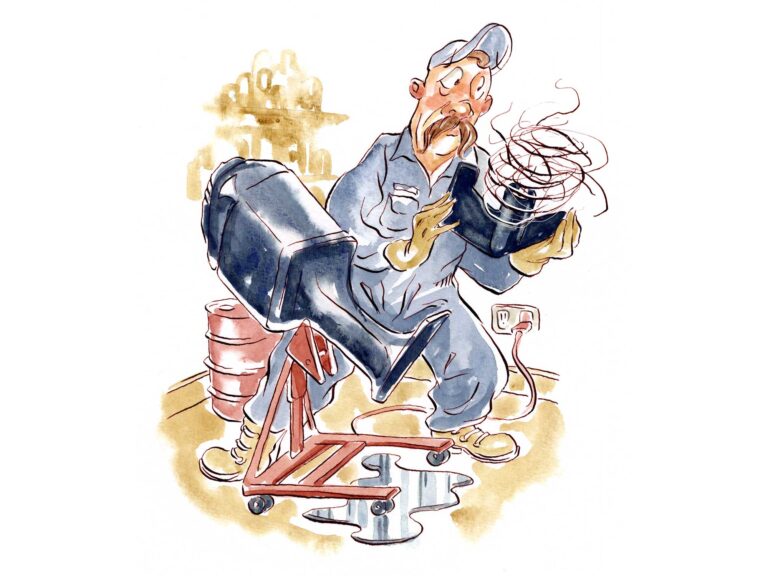
The Key to Successful DIY Maintenance
DIY maintenance offers the opportunity to learn more about your boat and engine, but you have to do it right.
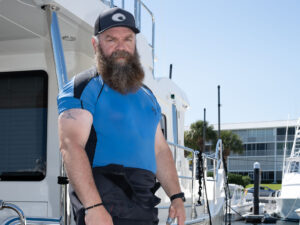
On Board With: Jeremy Dennard
Jeremy Dennard turned his love for scuba diving into a career helping people maintain their yachts and boats.

Catching a Swordfish on a PWC
Is a personal watercraft capable enough to be used for landing a swordfish? Emmanuel Williams says, “Just ’Doo it.”
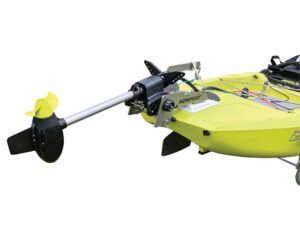
Installing an Electric Motor on a Kayak
Newport’s electric motors can turn your kayak into a performance machine that’s well-suited for chasing a variety of fish.
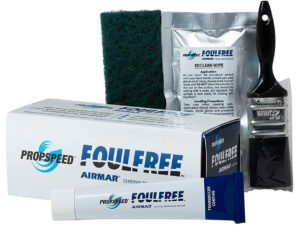
We Test: Foulfree by Propspeed
Certified by Airmar, this foul-release coating kept the author’s transducer free of marine life.
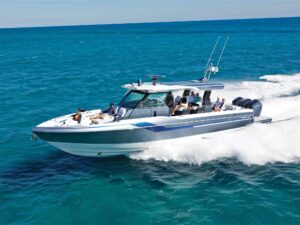
Boat Test: 2024 Formula 457 CCS
The 457 CCS delivers a combination of performance, luxury, versatility and great opportunities for owner personalization.
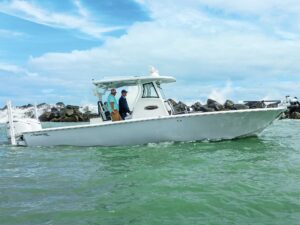
Boat Test: 2024 Tidewater 3100 Carolina Bay
Tidewater’s 3100 Carolina Bay, the world’s largest bay boat, can fish skinny or blue while also offering comfortable cruising.
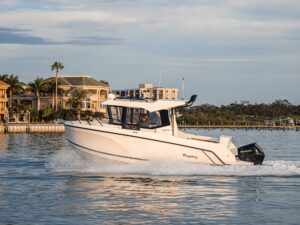
Boat Test: 2024 Bayliner Trophy T23 Pilothouse
The new Bayliner Trophy T23 Pilothouse gives anglers a boat capable of extending their season on both ends.
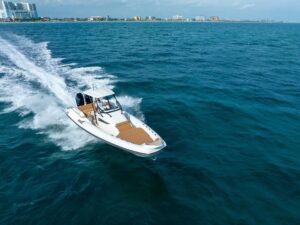
Boat Test: 2024 Nuova Jolly Prince 33 CC
The Nuova Jolly Prince 33 CC combines superb handling with a variety of creature comforts in a package that’s a ton of fun.
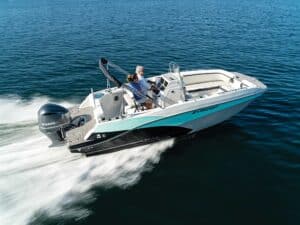
Boat Test: 2024 Starcraft SVX 231 OB CC
The Starcraft SVX 231 OB CC combines 360-degree fishability with family-boat comfort in a platform that’s very versatile.
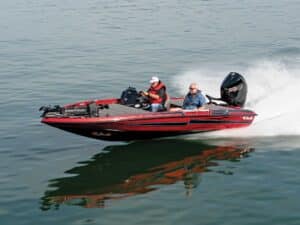
Boat Test: 2024 Bass Cat Caracal STS
The Bass Cat Caracal STS combines innovation, style, and durability in a fishing package that performs well.
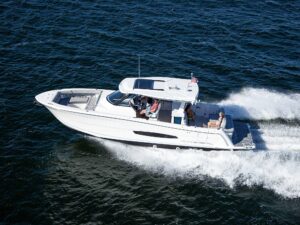
Boat Test: 2024 Regal 38 Surf
The Regal 38 Surf is not just the world’s largest wake surf boat. It also offers luxury, fishing, diving and overnighting.
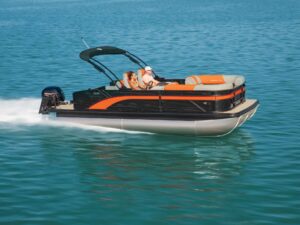
Boat Test: 2024 Bennington S20 Swingback SPS
Style, function and brand swagger converge at a surprisingly affordable price on the Bennington S20 Swingback SPS.
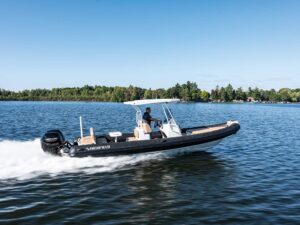
Boat Test: 2024 Highfield Sport 800
The Highfield Sport 800 offers a smooth, stable ride that’s also very sporty thanks to the excellent power-to-weight ratio.
Boats and Engines

A New Electric-Powered-Boat Speed Record
Princeton Electric Speedboating, in coordination with Flux Marine, achieved a record speed for an electric-powered boat.
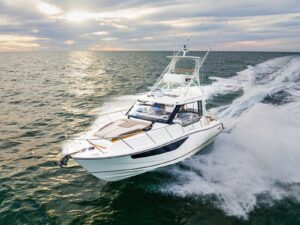
Boating On Board: Boston Whaler 365 Conquest
Innovative design for ultimate on-water experiences.
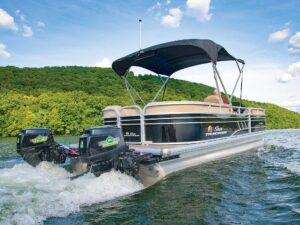
Using Hydrofoils to Improve Boat Performance
Electric-powered boats have some weight issues due to their batteries. Hydrofoils may be able to help overcome that problem.
Runabout Boats
Watersport boats.

What to Do if Your Boat’s Engine Dies
Losing power while boating can be a daunting experience if you’re not prepared. Here are four tips to improve your safety.
Boating Gear
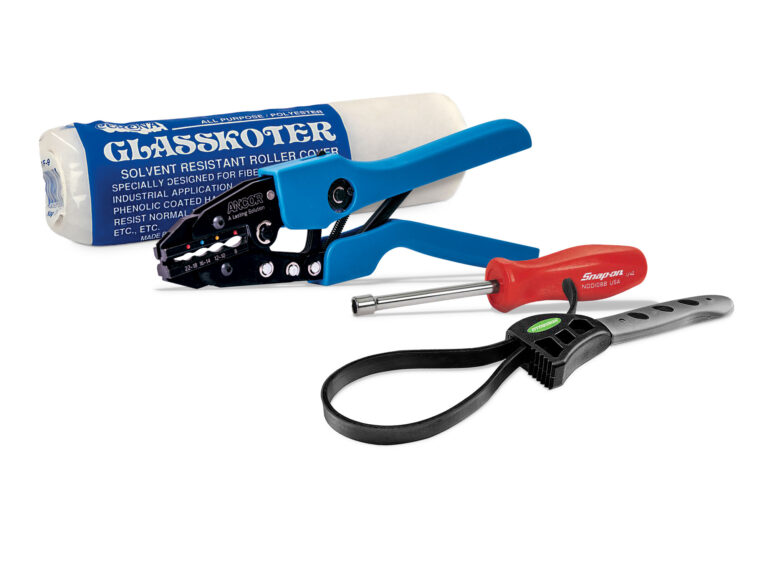
Six Tools for Spring Make-Ready
Spring commissioning involves a variety of tasks. These six tools will help you get your boat ready for the season.
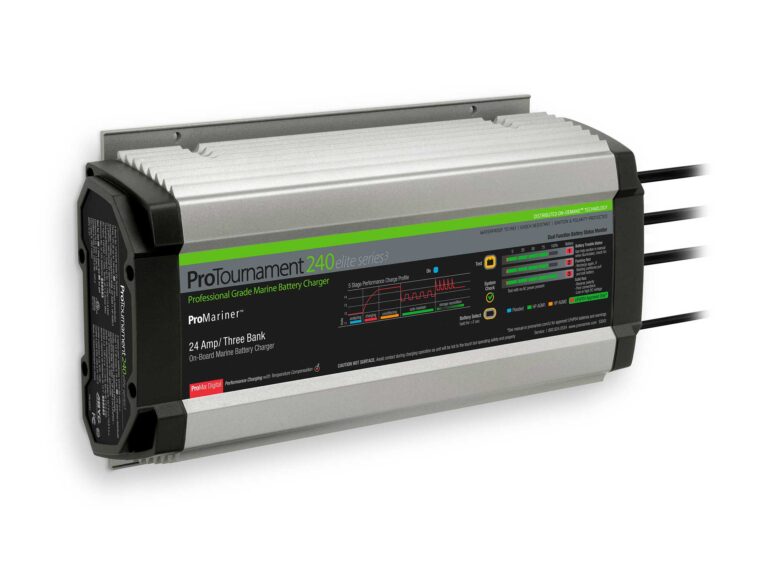
ProTournament Elite Gen 3 Chargers
ProTournament Elite Gen 3 battery chargers are packed with tech features to deliver the fastest-possible recharge times.
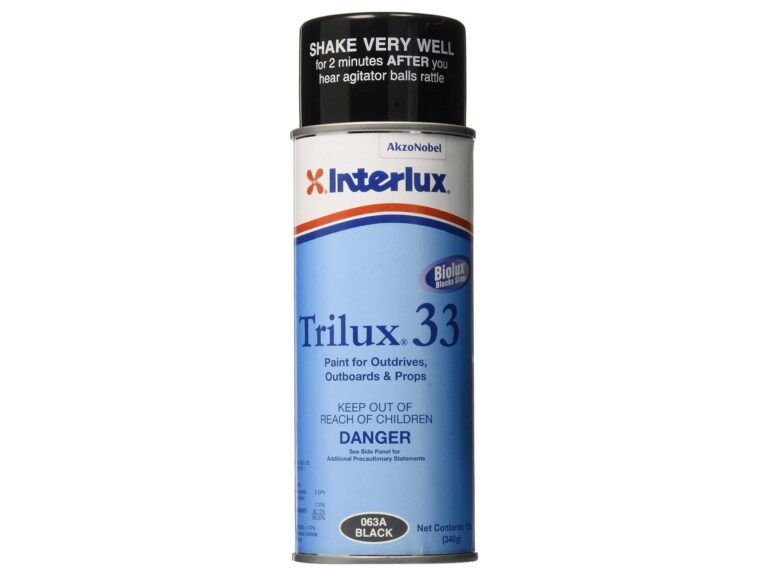
We Test Interlux Trilux 33 Aerosol Antifouling Paint
The spray formulation of Interlux Trilux 33 antifouling is put to a season-long test.
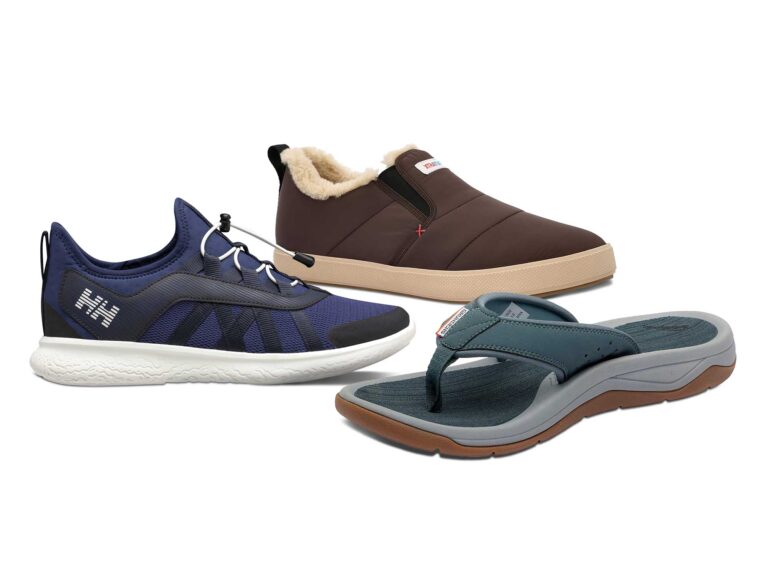
Boating Shoes for Spring and Summer
Boaters have more choices than ever when it comes to deck shoes. Here are three to consider for the spring and summer months.
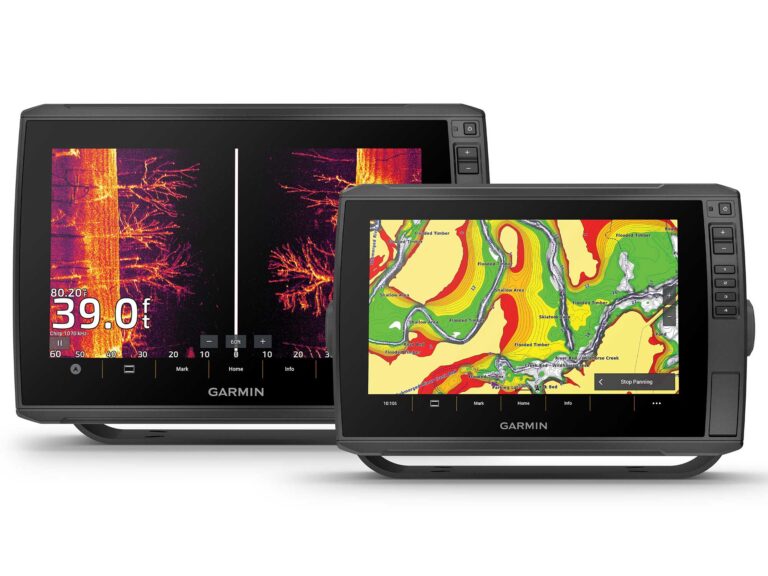
The Garmin EchoMap Ultra 2 Series: Advanced & Affordable
The EchoMap Ultra 2 is an advanced yet affordable chart-plotter display suited for freshwater and nearshore boating anglers.

- Digital Edition
- Customer Service
- Privacy Policy
- Cruising World
- Sailing World
- Salt Water Sportsman
- Sport Fishing
- Wakeboarding
Many products featured on this site were editorially chosen. Boating may receive financial compensation for products purchased through this site.
Copyright © 2024 Boating Firecrown . All rights reserved. Reproduction in whole or in part without permission is prohibited.

Boat Trailers: The Ultimate Buying Guide
Written by Carolyn Jackson
See a real price on boats with GoRollick. See Pricing
Maybe you just bought your first boat. Congratulations! Or perhaps you just upgraded to a larger boat. Or perhaps you’re just curious. Either way, when you are in the boating world, understanding boat trailers are usually an additional requirement. Although you can leave your boat at a marina in the water year-round, there are some exciting benefits to utilizing a boat trailer:
- You can transport your boat to different bodies of water at any time
- You can easily remove your boat in the case of inclement weather
- If you permanently trailer your boat, you will save money on slip fees, blistering, and bottom repairs.
In this ultimate buying guide to boat trailers, we’ll discuss boat trailers’ ins and outs: how to pick one, how much they cost, and how to use a boat trailer. So strap in, and let’s get rolling.
Key Takeaways:
- Boat trailers are convenient and cost-effective for boaters
- Most boat trailers will cost between $500 and $5,000
- Learning to haul a boat trailer safely is just as important as learning how to operate a boat safely
Table of Contents
What are the Benefits of a Boat Trailer?
Access and mobility are two of the most rewarding benefits of owning or having access to a boat trailer. Yes, storing your boat at a dock or marina adds ease of use, but without a trailer, you are limited to that one body of water and unable to relocate your boat or send it to dry storage for the winter.
The main benefit is the ability to travel with your boat and take it to new locations, be it a lake, ocean, river, inlet, or bay. You could even visit multiple spots within the same weekend. If you live in a colder climate, you can transport your boat to a warmer body of water during the winter and continue to enjoy the benefits of boating. If you are a fisherman, you can visit different spots to try fishing for other varieties. If you are a water skier or water sports athlete, you can try out new bodies of water with like-minded communities or trick courses available.
Another benefit of owning a trailer is peace of mind. If a hurricane or derecho or any other dangerous conditions roll into where you store your boat on the water, you can quickly load the boat on a trailer and take it somewhere safe on land. The likelihood of damage is significantly less for a boat stored on dry land vs. a boat docked in the water. If you consistently take your boat out of the water after each use, you also decrease your time and money spent on repairs like bottom fixes and blistering and save money on slip fees.
Long story short, access to a boat trailer is always a good idea, and understanding how to use a boat trailer safely is equally essential. You want your boat to last for many years, and you want as few bumps in the water as possible during that time; utilizing a boat trailer aids in that goal.
How Do I Pick a Boat Trailer?
The two most important factors when choosing a boat trailer are size and frame. You will need to select a trailer that suits your boat’s size, and then you can choose the frame based on your personal preferences.
Trailer Size
Step one is choosing a trailer size that actually fits your boat. Although it seems obvious, you will need to know the length and weight of your boat. To get the correct length, measure from the farthest point at the bow to the end of the hull’s running surface.
Generally, a trailer is about two feet longer than the boat it carries.
Pro Tip: when determining your boat’s length, do not use Length Overall (LOA). LOA can include extended swim platforms and other add-ons that will not influence the trailer’s length.
Trailer Weight
When determining the boat’s weight to estimate your trailer needs, you will need to go a little deeper than just what the manufacturer says the weight is on the spec sheets. The spec sheets do not include any cargo you have on board, fuel weight, additional features you have added, water, and other items like batteries, gear, etc.
The weight is essential for determining the axles on the trailer. Typically, boats over 3,500 pounds required a tandem axle trailer, and boats under the 3,500-pound mark can use a single axle trailer.
Boat Trailer Frame
There are two types of frames for boat trailers: steel and aluminum. There are benefits to each frame type, and which you choose comes down to personal preference.
Steel Frames
Pros:
- Strong and durable
- Well-protected wiring and brake lines
- Can be painted to match boat or towing vehicle
- Prone to rust and corrosion
- Painting, though inexpensive, can require additional maintenance
Pro Tip: If you want a steel boat trailer and do not care about the color, opt for a galvanized finish. Especially if you are using a boat in saltwater, this offers protection from corrosion that paint will not.
Aluminum Frames
- Excellent strength-to-weight ratio
- Less strong than steel
- Less protection for wiring and brake lines
Boat Trailer Brands
When selecting a boat trailer, you might feel overwhelmed by the amount of selection available. Most of the time, your manufacturer will have a preferred brand to use with their boats, or the boat dealer will be able to select some top choices for you. Nonetheless, here are some of the most common boat trailer brands on the market today:
BackTrack Trailers
Bass Cat Boats
Bear Trailer Manufacturing, Inc.
BoatMate Trailers, LLC
Continental Trailers
Coyote Manufacturing Company
EZ Loader Boat Trailers, Inc.
Float-On Corp.
Gateway Materials
King Trailers, Inc.
Load Rite Trailers, Inc.
Midwest Industries, Inc
Rocket Trailers
Rogue Jet Boatworks, Inc.
Skeeter Boats, Inc
Trailmaster and Vanguard
Venture Trailers, Inc.
Waterland Manufacturing, Inc.
Yacht Club and Eagle Trailers
How Much Does a Boat Trailer Cost?
The cost of a boat trailer can range from $500 to over $10,000. The price depends on the materials, size, carrying weight, and design. We are going to give some examples of different types of common boat trailers.
Single-Axle Boat Trailer Cost
A single-axle boat trailer can cost anywhere from $700 to over $4,000. Smaller 10’ to 14’ boats are usually under $1,500 but remember that weight, towing capacity, size, and accessories can always increase the price tag.
For single-axle trailers that carry boats in the 16’ to 21’ range, you can expect to pay between $2,000 and $4,000.
Another thing to keep in mind is that sometimes you pay for a brand name. More popular and well-known brands such as LoadRite or EXLoader can charge more for their products for this reason.
Example:
Single Axle Pontoon Boat Trailer for 21′-23’ pontoons — $2045
- 2600 lb. capacity
- Trailer weighs 675 lbs
Thinking of buying a boat and a trailer together? Check out our guide to how much a boat costs . And if you’re looking for a bigger adventure, you can always explore how much a yacht will run you. When you’re ready, explore thousands of new and used boats for sale at GoRollick.com.
Double-Axle Boat Trailer Cost
A double-axle boat trailer will cost more than its single-axle counterpart, but they can safely handle longer, heavier, and larger boats. You can expect to pay between $1,500 and $6,000 for a double-axle boat trailer. Most boats that require a double-axle boat trailer are in the 18’ to 25’ range.
Tandem-Axle Boat Trailer for 24′-25′ Pontoon Boats — $3,595
- 5,500 lb. capacity
- Trailer weighs 1400 lbs.
What is a pontoon boat? We got you covered here .
Personal Watercraft (PWC) Boat Trailers Cost
Personal watercrafts like jet skis also require a trailer to move from location to location. Fortunately, manufacturers make smaller single-axle trailers specifically for personal watercrafts. These trailers usually cost between $500 and $4,000, depending on the frame material, towing capacity, weight, and size.
If you own two personal watercrafts, there are double trailers (available in both single and tandem-axle) for hauling both jet skis simultaneously.
Ironton Jet Ski and Personal Watercraft Trailer Kit — $580
- Steel Frame
- 610 lb. load capacity
2019 Magic Tilt Double PWC Single-Axle Trailer — $3,000
- 2,000 lb. load capacity
Thinking of buying a jet ski? Check out new and used jet skis for sale at GoRollick.com .
How Do I Haul a Boat Using a Trailer?
The first thing you need to think about when gearing up to haul a boat using a trailer is your tow vehicle. You need to have a vehicle available with a towing capacity to carry both the trailer’s weight and the fully loaded (gassed up, water tanks full, gear on board) weight of the watercraft. To find your vehicle’s towing capacity, consult your manufacturer or your manufacturer guidebook for your vehicle.
Another way to determine towing capacity for your vehicle is to follow these steps:
- Find out the curb weight of your vehicles, which is located on the VIN sticker
- Add the weight of passengers, fuel, and cargo to the curb weight
- Subtract this number from your vehicle’s GCWR, which is also found on the VIN sticker (you may have to look this up using your VIN# if it’s not on the door sticker)
= Your vehicle’s max towing capacity
The second thing to think about when towing a boat using a trailer is your hitch. This is what connects the trailer to your vehicle. Boat trailer hitches are rated by ‘Class,’ ranging from Class I, Class II, Class III, Class IV, Class V. Class I hitches are for smaller lightweight boats under 2,000lbs. Class II hitches are good for loads up to the 3,500lb mark. Class III hitches are for boats up to 5,000lbs. Class IV goes up to 12,000lbs, and Class V can tow as much as 18,000lbs. The capacity of the hitch includes the weight of the boat and the trailer’s weight.
Okay, now that you have all the properly fitted materials, it’s time to hook up the trailer to your tow vehicle. Here are the steps for this process:
1. Align the hitch and ball, then lower the trailer hitch down over the ball.
2. Close the latch and insert the safety pin.
Pro Tip: Never tow without the safety pin in place because the hitch might pop off the ball when you hit a bump
3. Cross the safety chains, and attach them to the tow vehicle. They should always be crossed so if the hitch fails, the chains will support the trailer tongue, and it won’t dig into the asphalt
- Safety chains are underneath the ball and hitch and criss-cross each other. They hook into a specified area to ensure that if the ball and hitch fails, you still have a backup safety measure, so the trailer doesn’t fall on the road or crash.
4. If your trailer has brakes, attach the safety line to the tow vehicle. (This will engage the brakes if, for some reason, the trailer comes free from the vehicle)
- These are safety brakes that are built into the trailer itself. If the vehicle becomes disconnected from the trailer, the wire will be pulled, and it will activate the trailer brakes so it will slow down. Think like the bracelet you wear on your wrist when you ride a jet ski that turns the machine off if you fall off.
5. Plug in the lights, and run a full check to make sure they’re all working.
- Your vehicle should be compatible with towing, which means there will be a clear place to plug in the trailer’s lights, which is a wire that comes with every trailer. Simply plug this into your vehicle (like plugging in a power cord) and then test them to ensure it is working correctly.
How to Get a Boat onto a Trailer
If this is your first boat or your first time using a boat trailer, you might be wondering how the heck you get the boat on it from in the water. It may seem obvious, but step one is to drive the boat to a docking site where you can back your boat trailer into the water and drive the boat up onto the trailer. There are a few best practices for getting a boat onto a trailer:
- Idle up to the launch ramp while you wait for the tow vehicle to back up into the water.
- The tow vehicle should be in park and use the parking brake once in position in the water.
- The tow vehicle driver can get out of the vehicle and help guide the boat onto the trailer.
- Make sure the bow peak is aligned with the bow stop on the trailer.
- The boat should be able to float onto the back ⅔ of the trailer bunks.
- Be conscientious of an outboard engine. If the boat docking area is shallow, you may need to trim the engine.
- Once the boat is on the bow stop of the trailer, your helper (driver of tow vehicle) can use the winch strap to pull the boat up snug to the winch post. Once this is done, secure the safety chain to prevent the boat from slipping.
- If the boat is crooked, you will need to back down the ramp and try to straighten it.
- Once the boat is secure, pull the tow vehicle out of the water and finish securing the boat out of the way of the launchpad.
Remember that every boat is different, and although these guidelines are helpful, you will need to take it slow and see how your boat reacts to launching and trailering.
Tips and Tricks for Towing a Boat Safely
Towing anything can be a challenge. It adds a lot of length to your vehicle, making turns and high speeds more difficult. We highly recommend practicing in an open parking lot or area before you tow anything on the road. To ensure you are towing a boat as safely as possible, we have some general guidelines and recommendations to follow:
1. Always check your vehicle and the trailer to ensure everything is in street-ready working order.
- Connections are all tight
- Walk around vehicle
- Ensure you have a chalk block
- Check all the lights (hazards, brakes, etc)
- Make sure the load is secure, and everything is strapped down
2. If you sense swaying when towing, stop and recheck everything.
3. Make wide turns to avoid clipping a curb or other obstructions.
4. Leave extra following room between your vehicle and those in front of you. When towing a heavy load, braking distance may be significantly increased.
5. When wind-blast shoves your rig sideways, you can minimize the effect by taking your foot off the accelerator. Do not step on the brakes.
6. Learn to use your side-view mirrors and not your rear-view mirrors. Consider getting an extender for your side-view mirrors if you need additional visibility.
7. As soon as you arrive at the boat ramp, walk back to the trailer hubs and check that they’re cool to the touch. If they’re hot, your bearings aren’t functioning correctly and need to be serviced immediately.
8. Practice! This is not something anyone knows how to do well without some practice. Practice making right and left turns, practice backing up, and practice accelerating.
New to buying a boat? Read our beginner’s guide to buying a boat , plus learn all the ins and outs of getting a boating license .
GoRollick Marketplace
When you’re ready to find your next boat, be sure to check us out at GoRollick.com .
- See nationwide inventory, specs, and incentive information
- Get an upfront, transparent price on your desired boat
- Receive special offers on both the boat as well as additional accessories
- Take advantage of Bonus Savings plus the option to Buy From Home from select Certified Dealers
- Shop at one of our Certified Dealers who are committed to providing an exceptional buying experience
Check out and Subscribe to the GoRollick YouTube Channel to watch reviews, test rides, and more!
You may also like

How To Save (And Make) Money With Your Own RV

Top 10 Ways to Get Outdoors in 2023
Leave a comment cancel reply.
Your comment
Get access to exclusive deals, updates on manufacturer rebates, and product reviews and test drives

Accurate Trailer Ratings Are Based On What? Understanding GVWR and Other Crucial Metrics
Feb 19, 2024 | TRAILERS

Have you ever wanted to buy a trailer, but you have no idea where to start? Trailer Ratings are based on what? Keep reading!
Whether you’re a seasoned RV enthusiast, a boat trailer owner, or are venturing into the world of hauling cargo, understanding trailer ratings is essential. It’s not just a matter of hitching your trailer and hitting the road; you need to be aware of your vehicle or boat’s weight limitations, how to match the right trailer to your needs, and – above all – ensure safety and compliance with the law.
Trailers, from utility rigs to boat trailers, to the luxurious campers seen traversing the countryside, are evaluated by several critical metrics that define their capabilities.
Let’s take a deep dive into these ratings and uncover their significance. Understanding gross vehicle weight ratings (GVWR), gross axle weight ratings (GAWR), tongue weight, and other specifications means making smarter choices and staying safe on the road.
Get A Quote!


Trailer Ratings Are Based on What? The Three Pillars of Trailer Ratings
To understand how your trailer is rated, you should know that it’s like a three-legged stool—GVWR, GAWR, and tongue weight each represent a leg.
1. Gross Vehicle Weight Rating (GVWR)
The Gross Vehicle Weight Rating (GVWR) is the absolute maximum that your fully-loaded trailer can weigh. It takes into account not only the trailer’s dry weight but also the weight of your cargo, passengers, and any fluids you may carry. It’s the big number that can’t be ignored. If you do, you risk damaging your suspension, tires, or the frame of the trailer.
2. Gross Axle Weight Rating (GAWR)
Gross Axle Weight Rating (GAWR) is more specific, focusing on the load that each axle can handle. It’s important to distribute your cargo evenly to ensure that no axle bears a disproportionate amount of weight. An imbalance could lead to swaying or even a catastrophic failure of one of your axles.
3. Tongue Weight – The Weight on Your Hitch
Tongue weight is the downward force your trailer’s tongue exerts on your hitch ball. This not only affects your vehicle’s handling but also its braking efficiency. A good rule of thumb is to keep tongue weight between 9-15% of your trailer’s total weight, for stability and control.

Trailer Ratings Are Based on What? The Legal Aspect
The Department of Transportation (DOT) sets strict regulations governing trailers and their load limitations. Beyond manufacturers’ ratings, there are state laws that can impose further restrictions based on the type of trailer, the vehicle you’re towing with, and the roads you’ll be traveling on. Ignorance isn’t a defense,
and violating these regulations can lead to fines, insurance issues, and penalties for overloading vehicles that can lead to damage or, worse, accidents.
It’s vital to know the limits set by the DOT and your state, and also the penalties you could face for exceeding them. Check your owner’s manual, and don’t hesitate to get in touch with the DOT or your state’s transportation department for clarification if necessary.

Trailer Ratings Are Based On What? How to Apply Ratings to Your Trailer Weight
Understanding what the numbers mean is one thing; applying them to your trailer is another. Here’s a breakdown of how to utilize trailer ratings practically.
Weigh Your Trailer Regularly
Knowing your trailer’s actual total weight is crucial. You might be surprised how quickly you can hit a trailer’s maximum weight with a few extra items. Regularly weigh your trailer to ensure you’re within the GVWR.
Ensure Proper Tongue Weight with a Scale
Tongue weight should be measured and adjusted with a tongue weight scale. It’s not enough to guess or rely on the manufacturer’s specifications.
Distribute Your Load Evenly
As discussed earlier, even weight distribution is essential for safe towing. Use appropriate tools like load-leveling hitches and sway control devices to distribute your cargo evenly across all axles.

Interstate Haulers always makes sure we know the laws and regulations of trailer ratings, so we can tow your boats, RV’s, and so much more!
Trailer Ratings Are Based On What? How the Tow Vehicle Affects Trailer Ratings
The plot of you and your family hitting the open road in that shiny, new RV trailer imagined in your backyard is a quintessential American road trip. But the narrative’s climax—a carefree adventure devoid of any towing troubles—rests considerably on an often overlooked character: your vehicle’s towing capacity. Failing to understand how your automobile meshes with your trailer can lead to a string of issues from vehicle damage to road safety concerns. Let’s hook up to the critical insights on how your tow vehicle directly changes the stakes in your trailer towing equation.
Understanding the Tow Rating Dynamic
The tow rating, or the maximum weight a vehicle can haul, is not fixed; it’s an intricate interplay of your vehicle’s properties and the trailer’s design.
Weight Capacity: Beyond the Numerical Myth
Lurking beneath this numerical limit is a complex web of factors—engine power, transmission strength, trailer coupler, trailer’s frame rigidity, and more. Exceeding these limitations doesn’t just strain the vehicle; it strains the relationship between the vehicle and the trailer’s design intent, often with expensive and occasionally dangerous consequences.
Power to Pull: The Might of Your Drive Train
It’s not just the muscles but also how they flex. Upgrading to a higher tow rating means more horsepower, torque, and potentially a stronger transmission . A well-equipped tow vehicle doesn’t just move weight; it maneuvers it confidently, especially on inclines and under heavy loads.
Systems in Sync: Brakes and Suspension
For your vehicle to be an effective pulling partner, its brakes, transmission, and stability control systems must be in optimal condition. They need to be able to manage the additional load, ensure safe stopping distances, and maintain control, especially during emergency maneuvers.
Towing Compliance: A Legal Obligation
Did you check your tow package? Is your load secure? The compliance conundrum leads to a patchwork of regulations that, when combined, create a legal landscape that’s often as varied as the scenery of your cross-country adventure. Avoiding the fines and legal quagmires means understanding the regulations and configurations you must adhere to.
Stability and Safety: The Ultimate Hitch in Towing
The hitch isn’t just a point of connection; it’s about making sure that connection is reliable. Weight distribution hitches and trailer sway control systems are your allies, ensuring that your tow package operates in harmony for a smooth and stable journey.
The Pursuit of the Perfect Tow Vehicle
From the bull bar to the tail hitch, every vehicle is built with a purpose. Selecting the right one can make or break your towing experience.
Trailer Ratings Are Based on What? Specification Matching
Demystifying the ‘specs game’ is all about finding harmony between your vehicle’s listed capabilities and the trailers you aspire to pull. It’s an exercise in precision where every pound matters and every inch of torque can be the difference between effortlessly cruising and white-knuckling turns.
Trailer Ratings are Based on What? Maintenance and Upgrades
Regular vehicle maintenance is the bedrock of a successful towing operation. It keeps all the systems and components at optimal functioning levels, especially when they are tasked with hauling a significant load.

Trailer Ratings Are Based On What? 6 FAQs About Trailer Ratings for Hauling Trailers
Navigating the world of trailer hauling can be overwhelming, especially when it comes to understanding the various ratings that dictate how much your trailer can safely carry. Whether you’re a seasoned pro or a greenhorn to the open road, knowing the ins and outs of trailer ratings is crucial for a safe and efficient journey. Here are the top six frequently asked questions about trailer ratings , demystified for your convenience.
1. Is It Safe to Max Out The Maximum Trailer Weight?
It’s never safe to push your trailer’s weight limits to their extreme and apply too much weight. These ratings are set by manufacturers after extensive testing to ensure safe handling and structural integrity. Operating above these limits dramatically increases the risk of accidents due to compromised braking systems, quicker tire wear, and a higher chance of swaying.
2. Can I Increase My Trailer’s GVWR or GAWR?
Unlike a vehicle’s power, which you can increase with modifications, you cannot raise a trailer’s GVWR or GAWR without fundamentally changing its structure. Even if you were able to modify it, doing so would void warranties and potentially make your trailer illegal for road use.
3. What Are Tongue Weight and Payload Capacity, and Why Do They Matter?
Tongue weight is the downward force the trailer tongue puts on the hitch ball, usually 10-15% of the total trailer weight. Pay load carrying capacity is the maximum weight a trailer can carry. Safe tongue weight and payload distribution ensure proper handling and performance, preventing accidents and reducing wear on vehicle components.
4. How Do I Calculate Trailer Tongue Weight?
The simplest way to calculate tongue weight is to use a dedicated scale that measures the weight placed on the hitch, but for an approximate value, take 10-15% of the trailer’s loaded weight. Distribute cargo in the trailer to achieve the desired tongue weight, typically around 60 lbs for every 500 lbs.
5. What Can Happen If I Don’t Pay Attention to My Trailer’s Weight Ratings?
Neglecting your trailer’s weight ratings can lead to numerous problems, including but not limited to:
Vehicle instability and swaying, especially at high speeds or in windy conditions
Overheating of vehicle components due to excess strain on the engine and transmission
Reduced vehicle and trailer control, making it harder to stop or maneuver
Premature wear on vehicle tires, brakes, and suspension
6. Can a Towing Vehicle With a Higher Gross Combined Weight Rating Tow Any Trailer?
Not necessarily. While a vehicle with a higher tow capacity can technically pull heavier trailers, other factors such as payload capacity, hitch type, and state regulations also come into play. Always ensure every element of your towing configuration is compatible with one another and adheres to local towing laws.
As you embark on your hauling adventures, remember that safety should always be your top priority. Understanding your trailers’ weight ratings isn’t just about following the law; it’s about ensuring you, your cargo, and everyone else on the road can arrive safely at their destination.

Conclusion: Trailer Ratings Are Based on What?
By understanding trailer ratings, you can make informed decisions about what trailer to purchase and how to safely operate it. Keep in mind that these ratings are not just guidelines; they are essential for your safety and the well-being of others on the road. So before you hit the open road with your newly hitched trailer, make sure you have a firm grasp on its GVWR.
Looking for something specific?
You May Also Like

Marine Max: Elevate Your Boating Experience
Apr 5, 2024 | Partners , BOATS
Looking to buy a new boat? Check out Marine Max! Boating isn't just a leisure activity—it's a lifestyle. With the wind in your hair and the sun on your face, the open water offers a sense of freedom unlike any other. For the discerning boating enthusiast, Marine Max...

RV Life 101: Best RV Movers in North Carolina
Mar 26, 2024 | RV Transport
Are you looking for RV Movers in North Carolina? Moving an RV can be both an exciting and daunting process. The idea of exploring new horizons, setting up camp at your dream location, and relishing the open road is exhilarating. However, the task of physically...

Finding The Best Boat Transport Company: Boat Transportation 101
Mar 22, 2024 | BOAT TRANSPORT
Are you looking for a boat transport company? In the world of transferring boats, one of the most challenging aspects of owning a boat can be transporting it. Whether you're moving boats to a new mooring, taking your boat for repairs, or selling it to a buyer across...
Privacy Policy
JavaScript seems to be disabled in your browser. For the best experience on our site, be sure to turn on Javascript in your browser.
- My Purchase Orders
- Compare Products

- Trailer Weights
Trailer Weights by Trailer Type
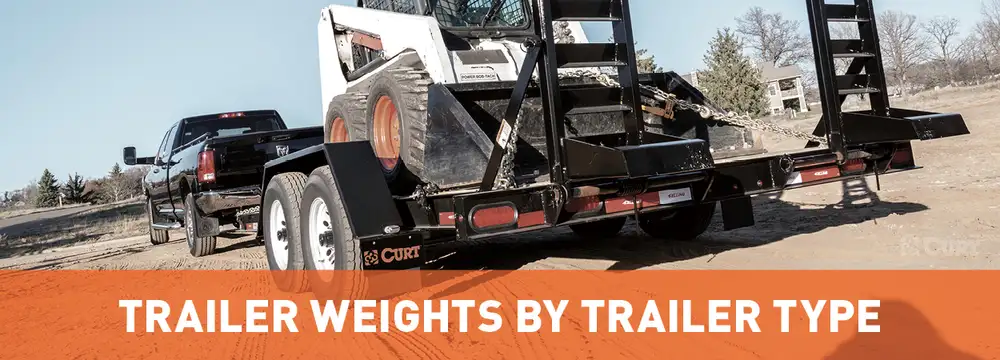
How Much Does a Trailer Weigh?
Each type of trailer has a specific purpose, and because of this, the weight of each trailer is different. Trailers also vary greatly in their capacities, lengths and construction.
This trailer weight chart and guide provides the average weight of each type of trailer, as well as the weight range, the gross vehicle weight rating (GVWR) and the average load capacity.
Warning! The trailer weights listed below are intended to be a general guideline only. The actual weight and ratings of your specific trailer will vary.
Trailer Weight Chart
Tap each trailer type to read more
Brief explanation of terms
- Empty Weight – The weight of the trailer without any cargo or fluids; also called Dry Weight or Unloaded Weight
- GVWR – The maximum weight a trailer is rated to weigh, including cargo, fluids, etc.
- Load Capacity – The total weight of the cargo a trailer is rated to carry
For further explanation of these terms, visit our Towing Capacity Guide .
Tow your trailer with the right hitch! Find a custom hitch made for your exact vehicle.

Camper Weight Chart
There are several different types of campers, from small teardrop trailers to deluxe 5th wheel RVs. This chart provides a focused look at average weights and capacities for most camper types.
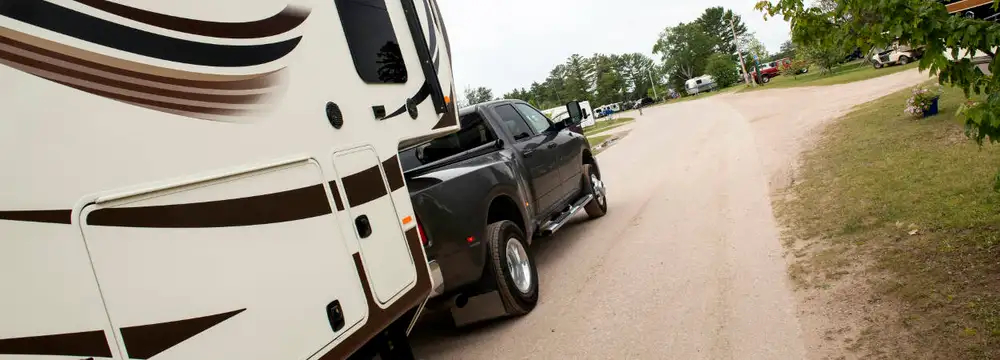
Trailer Weights Explained
Canoe / Kayak Trailer Weight
Canoe and kayak trailers are small trailers used for hauling personal watercraft such as canoes, kayaks and even paddleboards.
They typically weigh between 100 and 400 pounds when unloaded. The average weight of a canoe or kayak trailer is 200 pounds.
Depending on the number of watercraft the trailer is designed to carry -- one, two, four or more – the maximum trailer weight can be anywhere from 200 to 800 pounds.
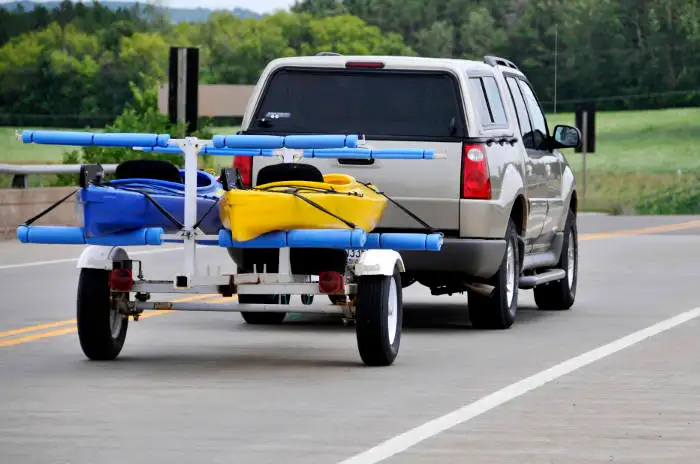
Jet Ski Trailer Weight
Similar to a small boat trailer, jet ski trailers have an average empty weight of 300 pounds. Smaller jet ski trailers weigh as little as 100 pounds and larger ones are closer to 500 pounds.
When loaded, the weight of a jet ski trailer can fluctuate from 800 to 3,000 pounds with an average load capacity of 1,500 pounds.
Weight ratings will differ based on the number of jet skis the trailer is configured to haul.
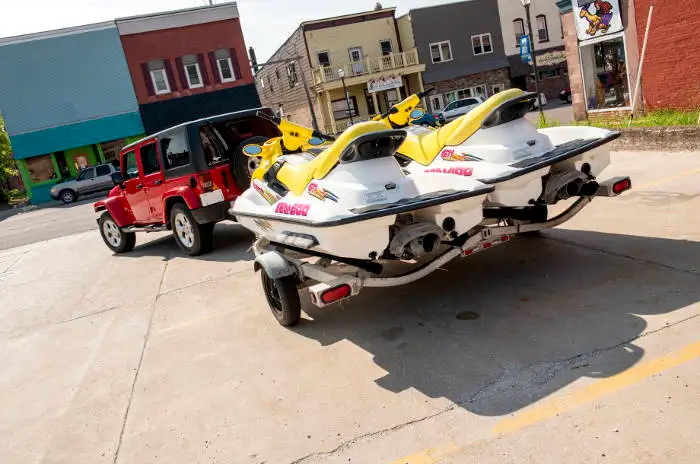
Motorcycle Trailer Weight
A motorcycle trailer is designed for transporting a motorcycle, allowing it to be towed by another vehicle. This is different from a trailer towed by a motorcycle, also known as a motorcycle trailer.
Unloaded, a motorcycle trailer may weigh 300 to 800 pounds with an average weight of 500 pounds. They are commonly rated for a maximum trailer weight of 1,300 to 3,500 pounds, making their average load capacity just under 2,000 pounds.
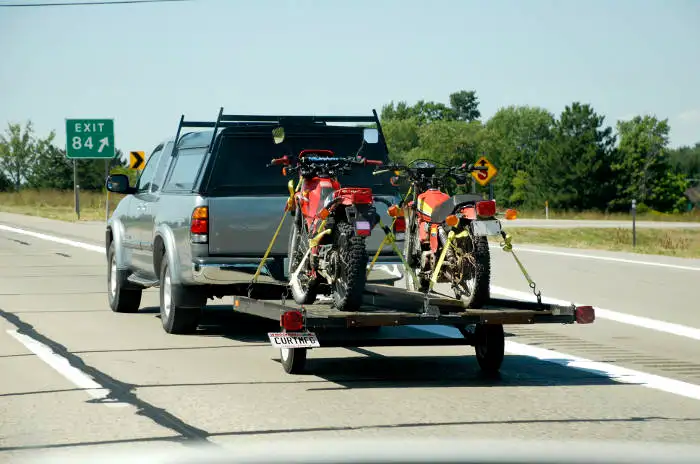
Fishing Boat Trailer Weight
A fishing boat trailer usually weighs 200 to 1,100 pounds on its own, without a boat loaded. The average for a boat trailer is about 600 pounds.
Combined boat and trailer weight ratings ranges from 900 to 6,000 pounds, depending on the length of the trailer and the boat itself.
The average weight capacity for a fishing boat trailer is about 2,700 pounds.
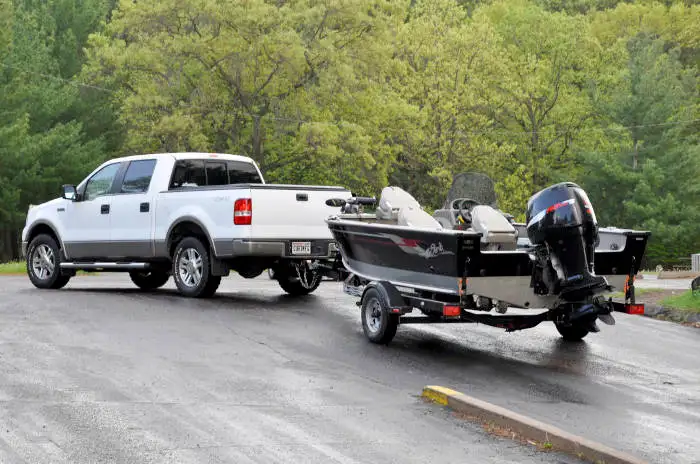
Tow Dolly Weight
A tow dolly for dinghy towing a vehicle usually weighs about 600 pounds without a vehicle hooked up. Some tow dollies weigh as a little as 400 pounds and others as much as 800 pounds, depending on the style and construction.
Tow dolly weight capacity ranges from 3,000 to 5,000 pounds. The capacity refers specifically to the total weight of the dinghy vehicle. However, the average capacity for most tow dollies is closer to 3,400 pounds.
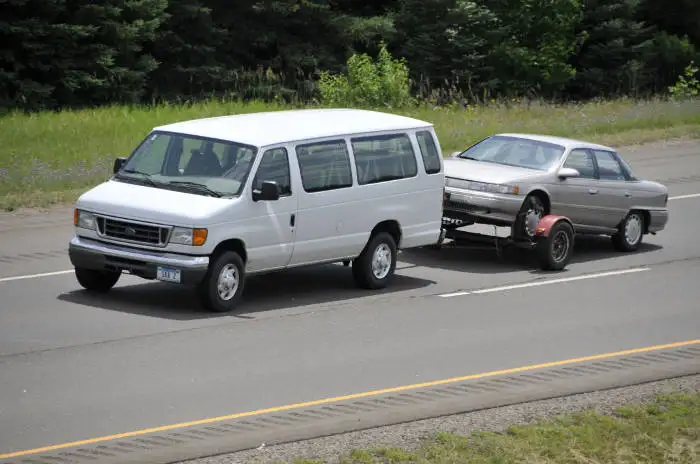
Small Open Utility Trailer Weight
Utility trailers typically weigh about 700 pounds unloaded, but they can vary greatly – from 300 to 1,100 pounds – depending on the construction, width, features, number of axles and more. The type of trailer referred to here is an open utility trailer less than 10 feet long.
The weight capacity of a small utility trailer can also range significantly. A short, aluminum utility trailer may only have a GVWR of 1,000 pounds, while a wide, double-axle, steel utility trailer may be rated for 3,000 pounds.
The average cargo load for small utility trailers is 1,800 pounds.
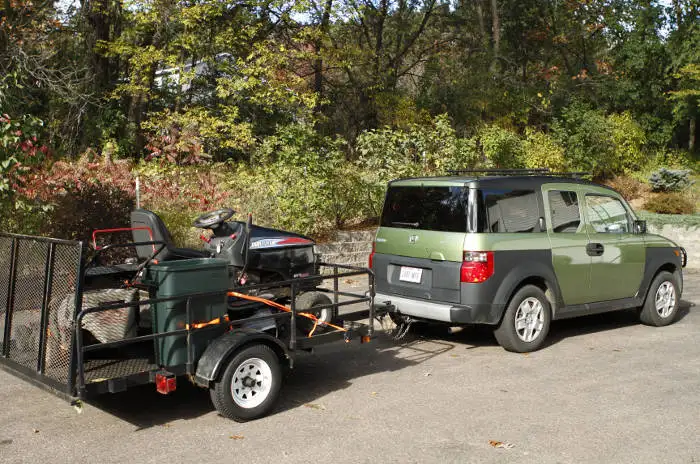
Small Enclosed Trailer Weight
Empty weight for small enclosed trailers spans from 400 to 1,800 pounds. The average for this type of trailer is 1,000 pounds, but this is determined largely by the materials used to construct the trailer and the number of axles.
When fully loaded, a small enclosed utility trailer can be rated for a maximum of up to 7,000 pounds (GVWR). However, for trailers 12 feet long or less, the average cargo load capacity is typically around 2,200 pounds.
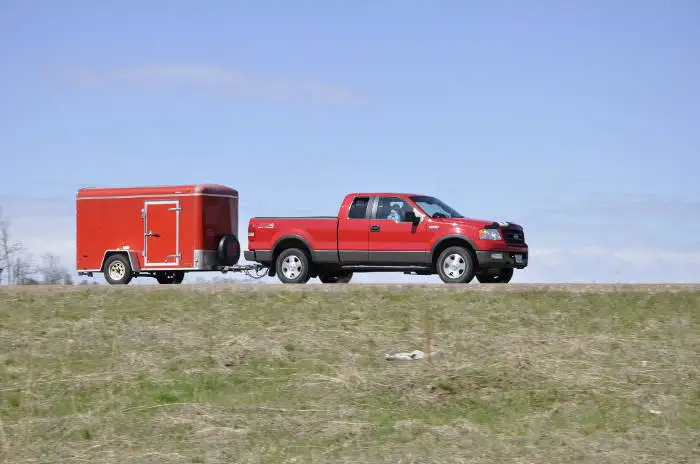
Teardrop Trailer Weight
Teardrop camper trailers weigh between 500 and 3,200 pounds, but the average is about 1,700 pounds. It all depends on the features included. Some teardrop trailers have a fully integrated kitchen and awning system. Others are more basic.
Maximum teardrop camper weight can be as much as 4,000 pounds (GVWR). Some are only rated for 2,000 pounds.
Most teardrop campers aren’t designed to tow a lot of weight, and the average cargo capacity is only about 700 pounds.
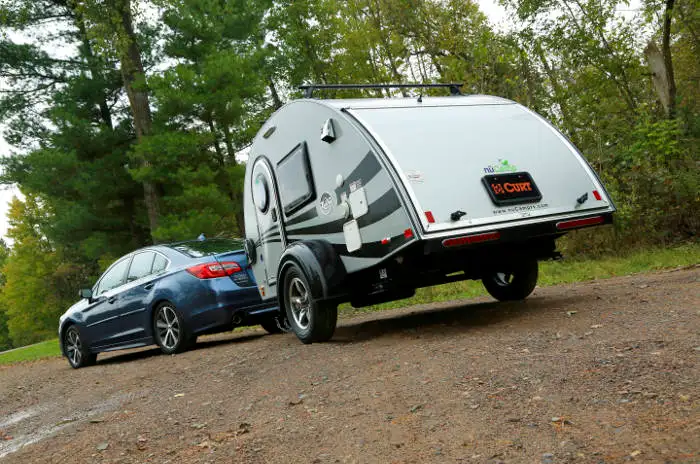
A-Frame Camper Weight
An A-frame camper is a specific type of pop up camper trailer. This type of camper usually weighs between 1,200 and 2,300 pounds unloaded. The average weight is 1,700 pounds.
A-frame campers provide a substantial amount of cargo capacity with an overall average of 1,200 pounds. Gross vehicle weight ratings for this type of trailer range from 2,500 up to 3,600 pounds.
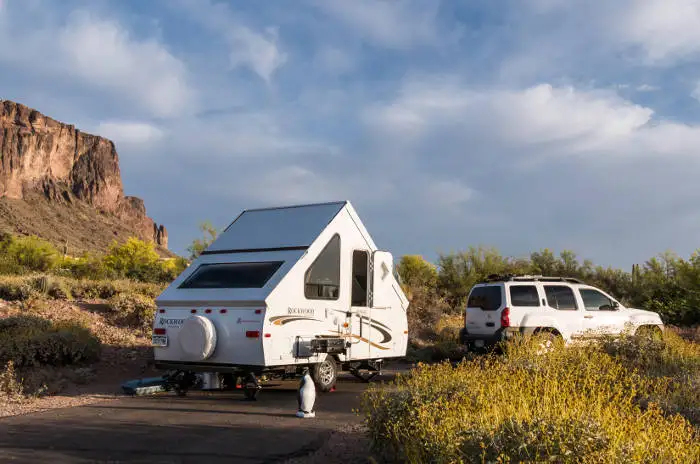
Car Trailer Weight
A car trailer can weigh anywhere from 1,500 to 2,800 pounds by itself. The average is 1,900 pounds. With one or more cars loaded, that weight increases to as much as 15,000 pounds.
The weight of a car trailer largely depends on its construction, length and style. A bumper pull car hauler with length enough for one car may have a GVWR of 6,000 pounds, while a double-car gooseneck trailer could max out at 15,000 pounds. Additionally, aluminum car trailer weight and capacity will vary greatly from steel.
On average, the load capacity for car trailers is 7,100 pounds.
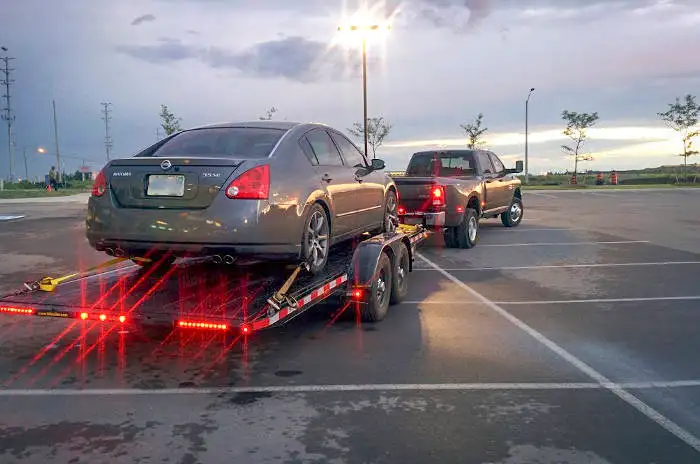
Large Boat Trailer Weight
Larger boat trailers are used for hauling yachts, pontoon boats and other heavy watercraft. For this type of trailer, the empty weight ranges from 1,100 to 4,400 pounds, and the average is about 2,200 pounds.
When loaded with a large boat, the trailer weight increases greatly. The capacity depends on the build of the trailer and its configuration. GVWR can be as low as 5,400 pounds or as high as 34,400 pounds.
Average load capacity for large boat trailers is around 11,400 pounds.
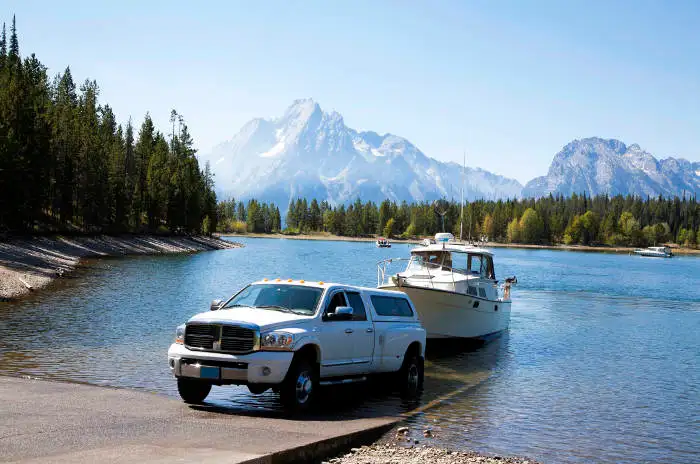
Pop Up Camper Weight
The average weight of a pop up camper is about 2,300 pounds unloaded. Some are as little as 1,400, and others weigh as much as 3,000 pounds if they are equipped with certain features.
When fully loaded (GVWR), pop up trailer weight can range from 2,700 up to 4,000 pounds, giving this type of camper an average load capacity of 1,100 pounds. This provides plenty of room for a propane tank, water tank, grille, bedding, luggage and other necessary cargo for a successful campout.
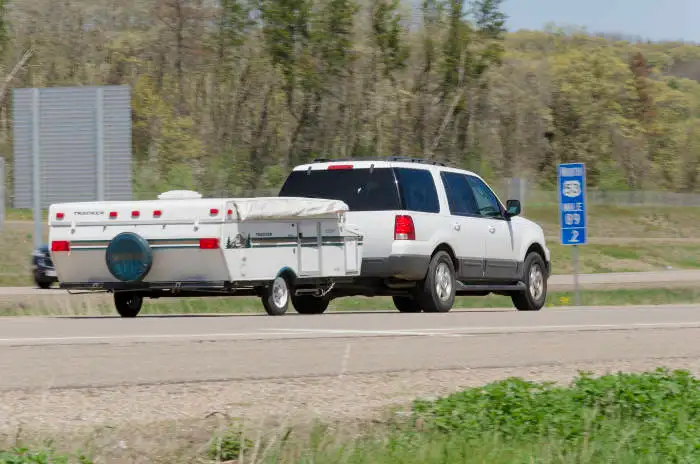
Large Enclosed Trailer Weight
Large enclosed trailers, namely those 12 feet or longer with a bumper pull coupler, typically weigh about 2,700 pounds when empty. Some are little as 900 pounds. Heavy-duty models weigh up to 5,200 pounds.
The capacity of a large enclosed utility trailer can vary based on how many axles it has, the construction of the frame and other factors.
In general, the average cargo capacity is 4,400 pounds. However, some 12-foot enclosed trailers only have a gross vehicle weight rating of 3,000 pounds. Longer units are rated as high as 10,000 pounds.
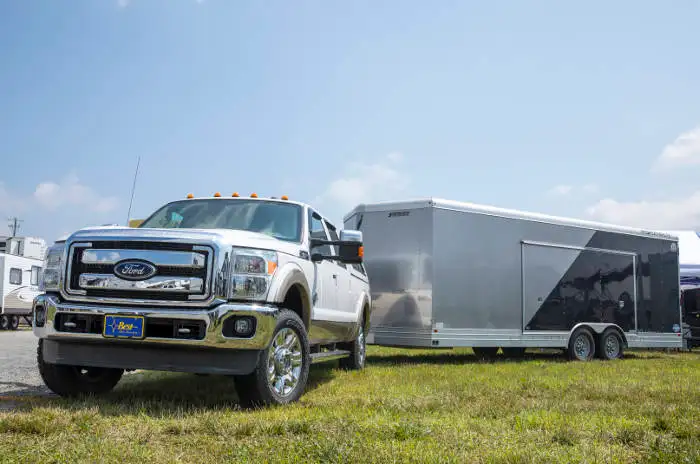
Small Travel Trailer Weight
A smaller travel trailer – about 22 feet long or less – has an average weight of about 2,800 pounds. The unloaded weight range is typically between 1,200 and 3,900 pounds.
The gross vehicle weight rating of small travel trailers varies from 1,900 pounds up to 4,500 pounds.
Generally, small travel trailers don’t have a lot of extra cargo capacity. The average is only about 800 pounds. However, some are rated to carry as much as 1,400 pounds. The cargo capacity may increase with certain design features and additional axles.
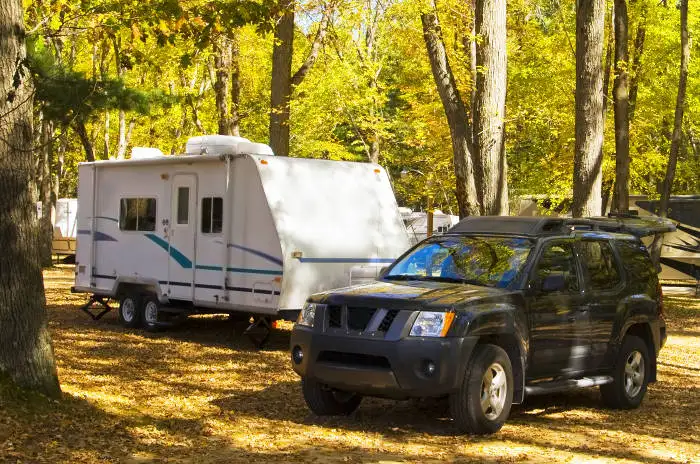
Small Horse Trailer Weight
A horse trailer designed to transport one or two horses typically weighs between 2,300 and 3,900 pounds. With horses and cargo loaded, this number increases. The average empty weight of a horse trailer is about 2,900 pounds.
When loaded up, small horse trailers max out at 7,000 or 8,000 pounds (GVWR). This allows for a cargo capacity of about 4,300 pounds.
Load capacities vary by trailer style and construction. A simple, one-horse trailer made from aluminum will weigh far less than a deluxe, two-horse trailer with a steel frame.
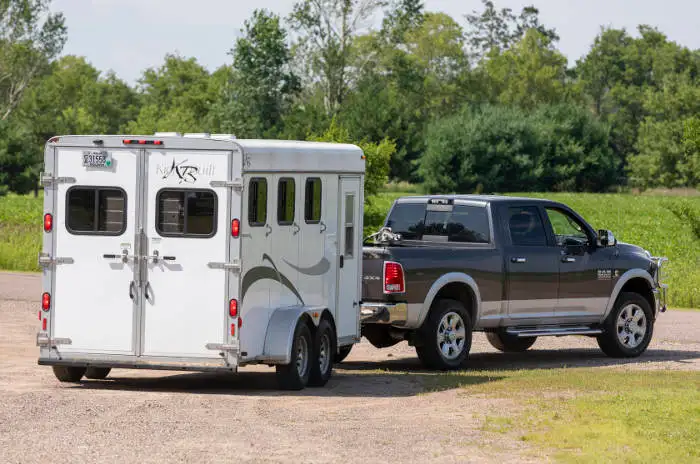
Large Flatbed Trailer Weight
Large flatbed trailers, such as car haulers, equipment trailers and utility flatbeds, can weigh anywhere from 500 to 7,700 pounds, even when empty.
However, because they are designed for transporting large amounts of cargo, most large flatbed trailers – that is, bumper pull flatbed trailers – have a higher cargo capacity. The average is about 7,400 pounds.
For gross trailer weight ratings on flatbed trailers, the low end is around 2,900, but some are rated as high as 26,000 pounds, even with a bumper pull configuration. Gooseneck models are rated even higher.
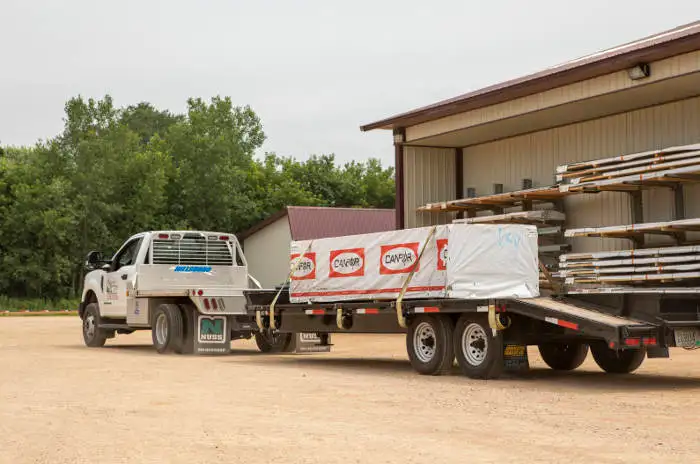
Dump Trailer Weight
When empty, a dump trailer can weigh anywhere from 1,100 to just over 10,000 pounds. The average weight for dump trailers is 4,500 pounds unloaded.
This type of trailer is extremely useful for transporting large amounts of fine or loose materials – everything from gravel to demolition waste. The hydraulic or powered dump receptacle makes unloading fast and easy.
The smallest dump trailers have a gross vehicle weight rating of 3,000 pounds. The largest models can weigh as much as 30,000 pounds. The average GVWR for dump trailers is around 12,400 pounds.
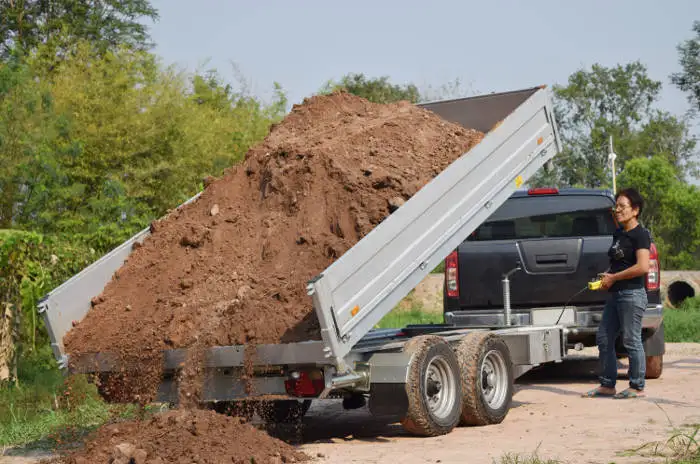
Large Travel Trailer Weight
A large travel trailer – anything around 20 feet or longer – has an average weight of about 6,700 pounds. Specifically, this refers to the travel trailer dry weight. This weight is largely dependent on the types of features and how many axles the trailer has.
Some larger travel trailers only weigh about 4,500 pounds, but the largest are around 9,000 pounds. 5th wheel camper trailers weigh even more.
When fully loaded with cargo, supplies and fluids, the gross vehicle weight rating of a travel trailer can vary from 6,300 to 10,500 pounds. The average cargo capacity of a bumper pull travel trailer is 1,600 pounds.
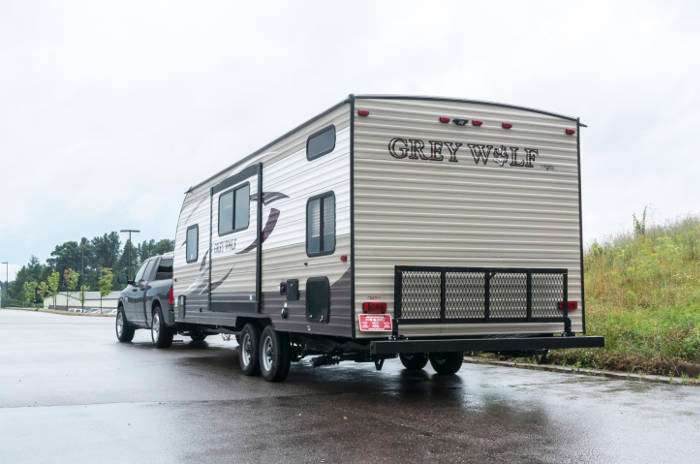
Gooseneck Flatbed Trailer Weight
Gooseneck flatbed trailers and utility trailers generally have higher weight ratings than their bumper pull cousins. A typical gooseneck flatbed trailer weighs about 7,000 pounds without cargo.
Smaller gooseneck flatbeds can weigh as little as 4,700 pounds, but the largest are upwards of 10,000 pounds.
For gross vehicle weight ratings, gooseneck flatbed trailers are built for heavy-duty hauling, whether it’s construction materials, farm equipment or automotive toys. Some are only rated for a maximum weight just under 16,000 pounds. Heavier-duty options are rated up to 36,000 pounds.
The average load capacity for gooseneck flatbed trailers is 16,000 pounds.
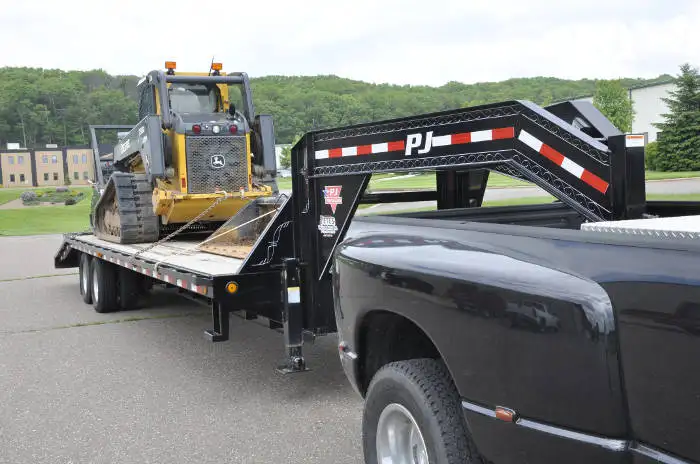
Large Livestock Trailer Weight
Larger livestock trailers range in weight from 4,200 to nearly 11,000 pounds when unloaded. With animals and cargo on board, that range increases up to 24,000 pounds (GVWR).
Livestock trailers are fairly diverse in their design and size. For example, a 20-foot aluminum bumper pull livestock trailer will be much lighter than a 40-foot steel gooseneck horse trailer. Some livestock trailers are also equipped with wash stalls, a living space and other features, adding to the overall weight.
The average empty weight for large livestock trailers is about 7,300 pounds. For load capacity, the average is around 11,400 pounds.
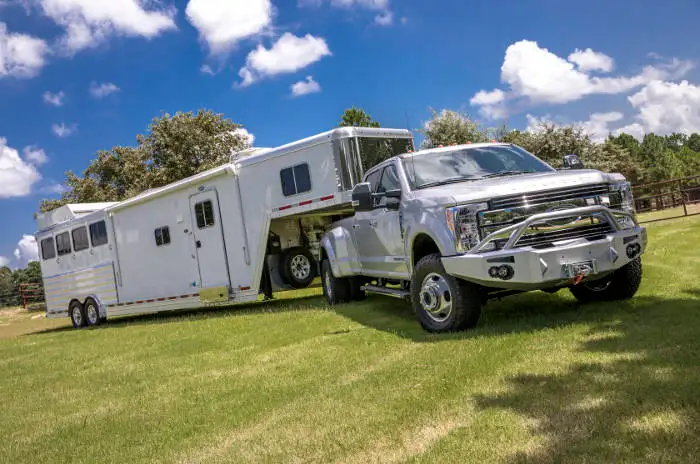
Toy Hauler Weight
A toy hauler is a bumper pull, 5th wheel or gooseneck trailer with a living space and a large compartment for transporting ATVs, UTVs, dirt bikes and other recreational motorsport vehicles.
Toy haulers, when unloaded, range in weight from 3,600 to 11,400 pounds, with an average of about 7,600 pounds.
Because they’re built for transporting smaller vehicles, toy haulers generally have a higher cargo capacity. The average is about 10,000 pounds.
Gross vehicle weight ratings for toy hauler trailer can vary from just under 15,000 to over 22,000 pounds.
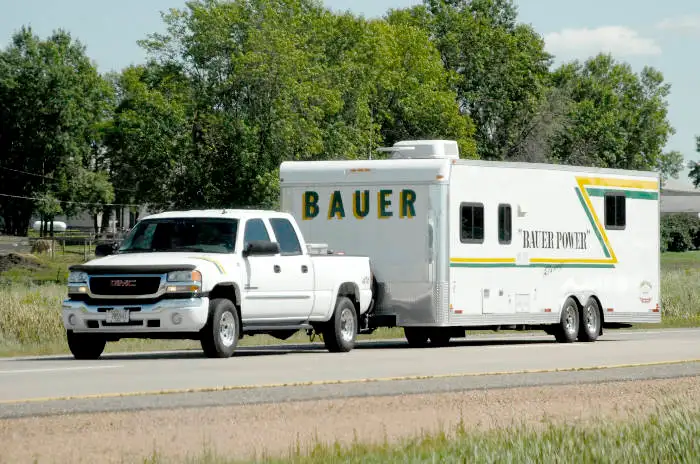
5th Wheel Camper Weight
5th wheel campers have an average weight of 12,700 pounds, empty and unloaded. Smaller models weigh as little as 5,000 pounds, while the largest 5th wheel camper trailers weigh up to 16,000 pounds.
To allow plenty of space for camping gear, equipment, cargo and fluids, the average load capacity is 6,000 pounds.
When fully loaded and ready for towing, most 5th wheel campers have a gross vehicle weight rating between 17,000 and 20,000 pounds.
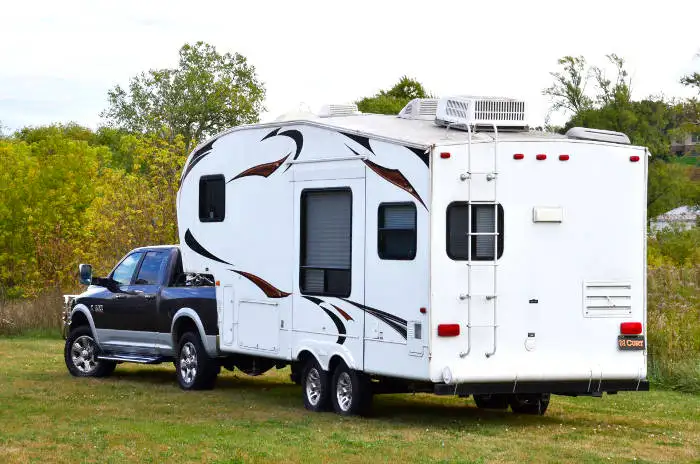
1. How much does a camper weigh?
A camper can weigh anywhere from 500 to 20,000 pounds. It all depends on the style of the camper. For example, a teardrop camper usually weighs about 1,500 pounds unloaded, while a 36-foot 5th wheel camper can weigh as much as 15,000 pounds, even when empty.
2. How much does a teardrop trailer weigh?
A teardrop trailer is one of the smallest camper types and one of the lightest. They typically weigh between 500 and 3,000 pounds, but the average is closer to 1,500. Some teardrop camper trailers have a gross vehicle weight rating as high as 4,000 pounds.
3. How much do pop up campers weigh?
Pop up campers weigh between 1,400 and 4,000 pounds. When empty and unloaded the average weight for pop up campers is about 2,300 pounds. However, they can also carry an average cargo load of 1,100 pounds. For maximum vehicle weight, a pop up camper can range from 2,700 to 4,000 pounds (GVWR).
4. How much does a small camper weigh?
A small camper can weigh anywhere from 500 pounds to 4,500 pounds, depending on the style. Teardrop campers, pop up campers and shorter travel trailers can all be classified as small campers. The average weight of a teardrop camper is about 2,000 pounds with cargo, and the average for small travel trailers is about 3,000 pounds.
5. How much does a travel trailer weigh?
Travel trailers vary in weight from 1,200 to almost 9,000 pounds. They come in various lengths, styles and builds, allowing for a diverse weight range. Smaller travel trailers have an average maximum weight of about 3,500 pounds (GVWR). Some larger travel trailers can max out at over 10,000 pounds when fully loaded up.
6. How much does a 5th wheel weigh?
5th wheel trailers are one of the heaviest types of trailer, with an average empty weight of about 13,000 pounds. The average gross vehicle weight rating for 5th wheel trailers is around 18,000 pounds, but some are as much as 20,000. Additionally, gooseneck trailers with a 5th wheel conversion can be even heavier.
7. How much does a boat trailer weigh?
Boat trailers by themselves can weigh as little as 100 pounds or as much as 4,400 pounds. The weight is determined by the length of the trailer and the type of boat or boats it is designed to carry. For example, jet ski trailers are about 300 pounds on average. Standard fishing boat trailers usually don’t weigh more than 1,000 pounds. Large yacht trailers, even without a boat loaded on, can easily be over 4,000 pounds.
8. How much does a boat and trailer weigh?
A boat and trailer together can weigh anywhere between 900 and 35,000 pounds. For small fishing boats and jon boats, the total weight for the boat and trailer ranges from 900 to 6,000 pounds. On the other hand, a heavy-duty yacht trailer and its craft together can easily weigh beyond 30,000 pounds.
9. How much does a horse trailer weigh?
Horse trailers vary in length, construction and features. A basic, aluminum single-horse trailer usually weighs less than 3,000 pounds. On the other hand, 12-horse trailers or horse trailers with a living space, elaborate wash stalls and other equipment can weigh upwards of 20,000 pounds.
10. How much does a 2-horse trailer weigh?
2-horse trailers weigh between 2,000 and 8,000 pounds. Some are more simple and constructed from lightweight materials. Others are more elaborate and longer, even though the horse capacity remains at 2 maximum. The average load capacity for a 2-horse trailer is about 4,000 pounds.
11. How much does an enclosed trailer weigh?
The weight of an enclosed trailer can fluctuate from 400 pounds to more than 20,000 pounds, depending on the style of the trailer and whether it is loaded with cargo or not. For example, a small, basic, enclosed utility trailer, empty of all cargo, may only weigh 500 pounds. Conversely, a toy hauler loaded up with a few ATVs might weigh in at 22,000 pounds.
12. How much does a car trailer weigh?
An unloaded car trailer usually weighs between 1,500 and 3,000 pounds. Gooseneck-style car trailers can weigh over 10,000 pounds. The construction, length and number cars the trailer is built to transport can make a huge difference. When loaded, the weight of some car trailers can increase to as much as 36,000 pounds.
Warning! The trailer weights listed on this page are intended to be a general guideline only. The actual weight and ratings of your specific trailer will vary.
Boat Reviews
- Aquila Boat Reviews
- Aspen Boat Reviews
- Avalon Boat Reviews
- Aviara Boat Reviews
- Axopar Boat Reviews
- Barletta Boat Reviews
- Bayliner Boat Reviews
- Centurion Boat Reviews
- Charger Boat Reviews
- Cruiser Yachts Reviews
- Formula Boat Reviews
- Fountaine Pajot Reviews
- Freeman Boatworks Reviews
- Galeon Luxury Yachts Reviews
- Intrepid Boat Reviews
- Jupiter Marine Reviews
- Manitou Boat Reviews
- Native Watercraft Reviews
- Phenom Yacht Reviews
- Pursuit Boat Reviews
- Sailfish Boat Reviews
- Sea Ray Boat Reviews
- Sea-Doo Watercraft Reviews
- SeaVee Boat Reviews
- Solace Boat Reviews
- Windy Boat Reviews
- X Shore Boat Reviews
- Yamaha Boat Reviews
- Boats Specs
- Marine Pros
- Boat Insurance
- Boat Warranties
- Boat Transport
- Boat Towing
- Marine Forecasts

Your Ultimate Boating Resource

2024 Pursuit OS 445: An Overview
Boat safety 101: exploring the serenity and adventure of boating, the moment of truth – 6 signs you need a new boat, is it possible to wakesurf on a pontoon boat, 2024 aquila 47 molokai review, 2024 sea-doo switch 13 sport review, 2024 aspen c120 review, choosing the right pwc trailer: tips and must-haves for a safe and smooth ride.
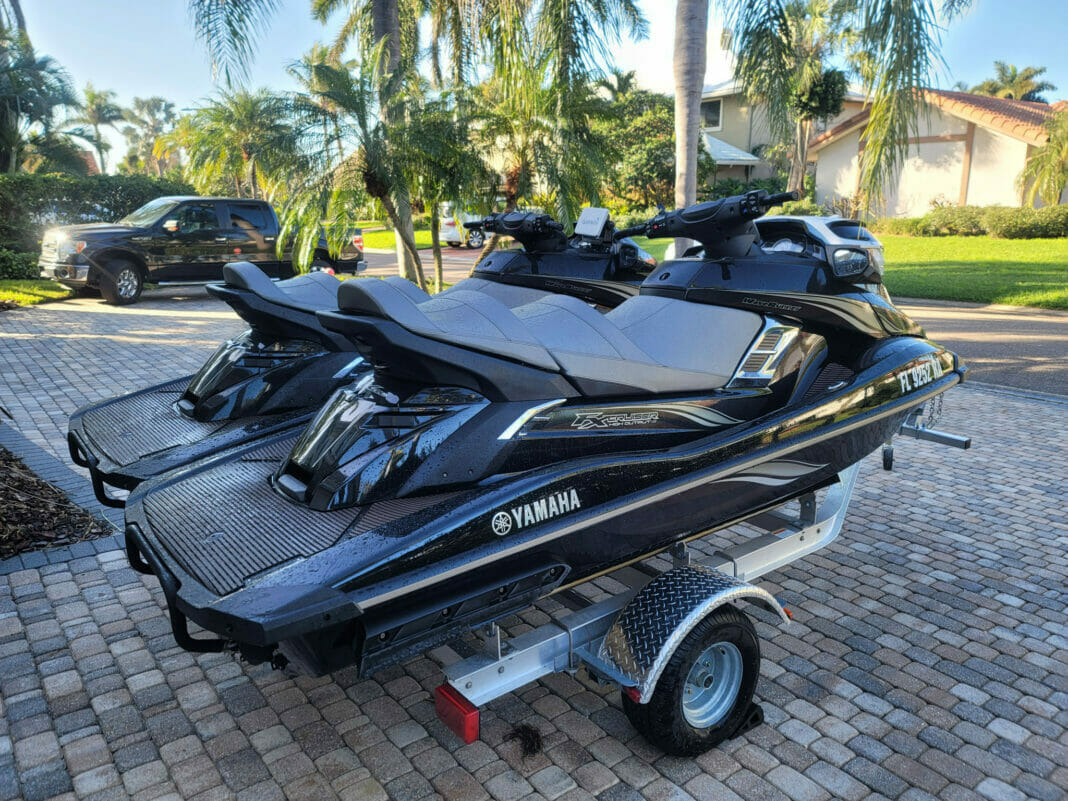
When purchasing a personal watercraft, it is important to remember that these vessels of fun cannot be driven on the road, which means you will need a way to transport them back and forth to the beach or any body of water. Many individuals become so excited at the purchase of their PWC (personal watercraft) that they forget that they will need a trailer equipped to transport the PWCs.
PWC trailers are a must-have and choosing one can seem complicated and overwhelming at first. This is because there are many different options available and the best trailer for you will depend on what your needs are.
When you first lay eyes on trailers for your PWC, you will notice they come in single, double, and even larger options. You can go with a traditional style, or you can choose a painted one. There are really many different options out there for you. Whether you are looking for the basic get me in and out of the water trailer or the spruced-up trailer, you can definitely find it.
In this guide, we will review the different things you need to consider as you choose the right PWC trailer.
Size of the Trailer
The size of the trailer you need will depend on the actual hull size of your PWC. When it comes to fit, you want your PWC to sit on the trailer without the rear of the PWC hanging off by more than just a couple of inches. It is important that the length of your trailer can accommodate the vessel to provide support to it. If the trailer is not sufficient in length, you may end up with a PWC in the middle of the road on your way to the ramp.
Ideally, you should choose a longer trailer of around six feet or so. The bunks should support much of the hull as this will allow for better support and control. If you are unsure of what trailer best fits your PWC, check with your local trailer manufacturer who can assist in answering questions and making suggestions.
Weight of the Trailer
The size of the trailer is important but so is the weight. When talking about weight, we are not talking about the actual weight of the trailer itself but the weight rating of the trailer. It is important to ensure that the trailer is of the proper weight rating to handle your PWC(s) so that you have maximum control of the trailer when you drive.
As you assess your PWC for its weight, make sure that it is fully fueled up as the fuel will add a substantial amount of weight to the PWC. An incorrectly weight-rated trailer will not properly hold your vessel and can lead to accidents on the road.
Ideally, you want the trailer’s maximum weight to be rated higher than the total load weight, as this will allow you some extra wiggle room.
Frame of the Trailer
There are several different types of frames available for you to choose from and the material of the frame will depend on what it is you are looking for.
One of the first choices is aluminum. These types of trailers last a long time and are lighter than some of the other options. They do not rust, which is why they are a popular choice amongst PWC owners. Since they are resistant to rust, they often demand a much higher price than other options out there on the market. A unique benefit to aluminum is that it is built with an I-beam, which allows you to hide the wiring and brake lines on the trailer.
Another choice, which is most commonly chosen is steel. This option usually comes either powder coated or painted. These are commonly chosen because they are considered very affordable. While they are economically viable options, they are prone to rust, which means you will need to do more trailer maintenance than you may need to do with other options.
You can also choose galvanized steel, which is a good choice when you want a steel trailer but you do not want to have to worry about preventative maintenance all the time. Galvanized steel can still rust but it is much more resistant to rust than traditional painted or powder-coated steel. The biggest downside to galvanized steel is that it will lose its shine over time. You will need to keep it polished to help restore the shine.
No matter which type of trailer frame you choose, you want to choose stainless steel hardware, especially for saltwater applications as they hold up well in these conditions. Other choices will corrode quickly and you will spend a lot of your maintenance time replacing the nuts and bolts.
Any one of these trailer frame materials is a good option and will hold your PWC and allow you to travel to and from the ramp with it. The decision will ultimately come down to your preferences and budget.
Suspension of the Trailer
Trailers have a suspension system installed on them to help with going over bumps and taking turns with a PWC attached to it. It is important to pay attention to the suspension that you do choose as there are two main types.
The most common and affordable option for a suspension system is a leaf spring. This suspension system is made up of thin steel plates that are stacked upon each other. The flexibility produced by the thin plates is what absorbs shocks. Leaf springs are able to be repaired or replaced should something happen to them, which is another reason why people tend to choose this system. With that said, they do require maintenance. If you plan to have a trailer with more than one axle, leaf spring suspension systems are best because each spring will operate independently of the others to provide the most comfortable ride and even wear on the trailer tires.
The second option is a torsion beam suspension system. This is a better suspension system, but it is also a great deal more costly. In a torsion suspension system, the axles are attached with an adjustable ride height and use a rubberized suspension. The inside of the axle housing will appear with four rubber cords that work to absorb shocks and provide suspension to the trailer. As the wheels on the trailer move up and down, the cords are compressed and provide you with a smooth ride.
What makes a torsion system better is that the torsion axles are made from galvanized steel and do not have any metal-to-metal contact, which means corrosion is unlikely to occur and is less of a worry. Since the axles are attached to the frame of the trailer, repair is impossible and the entire system needs to be replaced when there is an issue. With that said, very minimal maintenance is required for this suspension system.
Axles for Your Trailer
As we mentioned at the beginning of this guide, there are trailers with varying numbers of axles. How many you need will depend on what you plan to use the PWC trailer for.
Different axles are used to support different weights, so there is not just one answer to the question of how many you need without further evaluation of your needs.
Tandem axles or more than one is one of the preferred choices for PWCs as they offer better stability control, are much safer than their counterparts, and offer you a smooth ride on the road. Tandem axle trailers do come with a higher cost and maintenance requirements, but they are worth it, in the end, to not have to worry about much. They are an ideal choice if you can fit them into your budget, want to increase the number of PWCs you have at any point, or want something that will hold its value. The biggest downside to a multi-axle trailer is that your loads must ALWAYS be level and even or you risk uneven tread wear on the tires.
Single-axle trailers are going to be much easier for you to use, especially if you go to the beach daily. They are smaller, easier to maneuver and park, and are overall just convenient for most individuals. They are best if you are planning to transport just a single PWC as that is all it will hold. You will find that they are cheaper than a double-axle option, but it really comes down to how many PWCs you have.
Within the number of axles you need, you will also need to decide between a drop or straight axle. A drop axle works to reduce your ground clearance, which allows for much easier launching from the ramp and stability of the overall loaded trailer. Straight axles provide you with a good amount of clearance and are a good choice for individuals who plan to go in rougher terrain areas.
Bunks or Rollers for Your Trailer
Your PWC needs to be supported when it is on the trailer and the way that is accomplished is with either rollers or bunks.
Rollers are more convenient than bunks as they roll with the PWC to make it easier to load and unload your vessel but they are often very expensive to replace and they can break or stop rolling making it a challenge to get your PWC on and off the trailer. If you do plan to choose a trailer with rollers, it is vital that you secure and tie down the PWC EVERY time you take it out on the trailer as it could roll off otherwise.
Bunks are a common choice and are usually carpeted. They provide your PWC with the support it needs for its hull. You will find that the carpet starts to wear and tear over time and you will need to keep an eye out for damage. A damaged bunk can lead to a damaged hull. The carpet will need to be repaired or even replaced at some point in the lifetime of your trailer. Many people do choose to line the bunks with plastic or PVC to help ease the wear and tear.
Brakes for Your Trailer
Your trailer’s brakes are your stopping power and something you do not want to take for granted, especially carrying such a heavy load on them.
It is important to pay attention to your local state, city, or county laws as some require you to have brakes if your trailer weighs more than 3,000 pounds. In general, a light load can usually be stopped with the brakes on your tow vehicle and your trailer may not need any.
However, brakes are always a good idea, so you do not have to forego them just because you have a light load.
When it comes to brakes for your trailer, you will have four types to choose from, which include drum brakes, disc brakes, hydraulic surge brakes, and electric brakes.
Drum brakes are a choice that some trailer owners like due to their affordability. Drum brakes require a lot of maintenance, so this is something you want to be cautious about, especially if you do not like to do the upkeep routine.
Disc brakes are a bit more expensive than drum brakes but they tend to be easier to maintain and they are resistant to corrosion and rust. Disc brakes stop you quicker than drum brakes will.
Hydraulic surge brakes are commonly used on most trailers and are probably the type you will run into more than not. These types of brakes are activated when the momentum of the load changes or when the tow vehicle starts to slow down. This system is self-contained, so there is no hooking it up to the tow vehicle; however, it does take longer for these brakes to stop the trailer.
Electric brakes work right along with the tow vehicle, so there is no delay like there is with surge brakes. When you press the brake, the trailer brakes. If you do choose electric brakes, you want to make sure that they have been rated for marine use. You will need to make sure you keep up with maintenance on these brakes as well to avoid issues with the electrical components.
Tires for Your Trailer
The tires on your trailer are important and should NEVER be overlooked. Traditional tires should never be used on your trailer as they will not provide you with the support or safety you need to haul your PWC.
You should only use tires that are approved for trailer use and you want to ensure that the tires can handle the load you plan to put on the trailer. You can find the maximum weight load on the sidewall of the tires.
All trailer tires range in size from 8 inches to 13 inches and have a maximum lifespan of about 7 years, but should be looked at for replacement after 3 years.
Everything Else to Consider
There are some smaller components that you need to consider when you purchase your trailer as well. Just because these do not have their own subtitle does not mean they are any less important than the above.
1. You do need a way to attach the trailer to your tow vehicle.
The best way to do this is to utilize a ball tow hitch and a coupler. The coupler on the trailer will attach to the ball hitch that is on the tow vehicle. On the coupler is a lever that holds a cotter pin and a hole. The pin is used to secure the lever into a closed position. Most people do not like to leave the cotter pin in place as it is not secure. You can replace the pin with a padlock to help offer better security.
2. Safety chains are a good addition.
While you do not necessarily need safety chains, they are always recommended as they help to add another layer of security when you tow your trailer. Should the coupler fail or become disconnected from your tow vehicle, the safety chains will keep the trailer attached.
3. You need lights for your trailer.
No trailer is complete without lights. The best choice for any trailer is LED lights over traditional incandescent lights. LEDs will last a lot longer and are brighter, which makes them easier to see, especially at night.
4. Securing your PWC to the trailer itself.
One of the best ways to secure your PWC to your trailer is through a winch. Most people choose a winch as it helps to load and unload the PWC into the water and makes it very convenient. You can also utilize a safety chain or strap in addition to the winch for ultimate security or in case the winch breaks for some reason.
5. Final elements to think about.
Some of the final things you want to think about for your trailer include a spare tire carrier, tongue jack, composite fenders, and bearing protectors. These will all assist you in properly taking care of your trailer and offer maximum protection when you use your trailer on the road and at the ramp.
The Best PWC Trailer for You Awaits
Now that you know what makes up a good PWC trailer, you can get out there and choose the one that best meets your needs and fits your budget. You definitely do not want to skimp when it comes to your trailer because it is a very important piece to the puzzle. Without your trailer, your PWCs will not make it to the ramp.
While a trailer is probably the last thing on your mind as you purchase your PWC, you will quickly find that you need one. Choosing the best one matters and will make your life much easier.
RELATED ARTICLES
Boat trailer regulations and laws: a comprehensive guide for boat owners, essential upgrades for your boat trailer, trailer essentials: maintenance tips and lights, pwc safety 101: a comprehensive guide to personal watercraft safety, winterizing your boat trailer: essential steps for a painless boating season, latest posts, the top 9 reasons to maintain a meticulous boat log, don't miss, our newsletter.
Get the latest boating tips, fishing resources and featured products in your email from BoatingWorld.com!
Eco-Savvy Sailing: Expert Tips for Reducing Fuel Costs and Enhancing Your Boating Experience
Sea safety blueprint: constructing the perfect float plan for your boating adventures, what type of wood is used for pier pilings, what is the difference between a dock and a floating pier, what is the proper technique for pulling a beginner wakeboarder, what does ‘no wake’ mean on a lake, what is the difference between wash and wake, 10 essential tips for fishing near private property, the benefits of using a drift sock: guidance for anglers, lure fishing: secrets for imitating live bait and attracting fish, explore the untapped depths of america’s best bass fishing spots, tackle your catch-and-release adventures with these 6 tips, outboard motor maintenance: tips for keeping your engine in top shape, the essential boat tool kit: tools every boater needs, diy boat building: 8 tips and tricks for building your own vessel, the art of miniature maritime craftsmanship: ship in a bottle, antifouling paints: a guide to keeping your boat shipshape, beginner’s guide to standup paddle boarding: tips and techniques, boating for fitness: how to stay active on the water, kayak safety: how to stay safe on the water, anchoring in a kayak or canoe: how to secure your small boat, 2024 yamaha 222xd review, 2024 sailfish 316 dc review, 2023 seavee 340z review, 2023 centurion fi23 review, gear reviews, megabass oneten max lbo jerkbait review, fortress anchors fx-7 anchoring system review, fortress anchors fx-11 anchoring system review, fortress anchors commando anchor kit review, fortress anchors aluminum anchors review, stay in touch.
To be updated with all the latest news, offers and special announcements.
- Privacy Policy

Boating Basics Online is reader-supported. When you buy via our links, we may earn a commission at no cost to you. Learn more
Trailer Ratings Are Based on What? (Answered)
Written by J. Harvey / Fact checked by S. Numbers
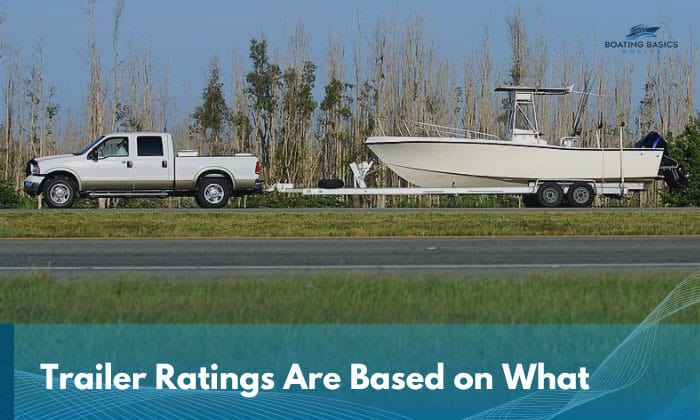
Whether you’re studying for an exam or are just curious about the question, “Trailer ratings are based on what?”, you can get a comprehensive answer and detailed explanation here.
Trailers are mainly rated based on their gross trailer weight rating (GTWR), tongue weight, as well as the trailer’s length and width. Other factors that influence it are the boat’s weight, trailer type and capacity, and the towing vehicle’s capabilities.
Table of Contents
1. Gross Trailer Weight Rating (GTWR)
2. tongue weight, 3. trailer length and width, key factors influencing trailer ratings, frequently asked questions, evaluation criteria for trailer ratings.
Overall, the factors mentioned in the introduction are the yardsticks that manufacturers use when determining the boat trailer rating, which in turn, is reflected on its capacity plate as Gross Vehicular Weight Rating (GVWR).
The GVWR may be what the actual trailer rating is, but to those curious about “What are trailer ratings based on?”, look no further than the following.
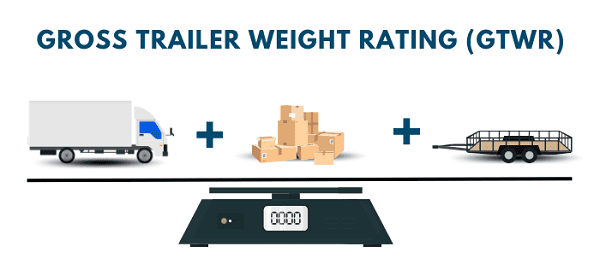
This is the sum of the boat’s and trailer’s respective weights as well as all the cargo you’re carrying. It’s specified as the trailer’s Gross Trailer Weight Rating (GTWR) or Gross Trailer Weight (GTW).
Some prefer to remove the “R” or Rating to confirm that it’s not an actual rating and, of course, to not confuse it with the GVWR of the boat trailer.
The GVWR differs from the GTW in that it refers to the total weight the trailer can carry minus its empty weight. As such, the latter is often lower than and should not exceed the former.
The GTW and empty weight are not always indicated on the trailer. If that’s your case and you have the time, you can use a public weighing scale and measure it yourself. You just have to make sure that only the trailer, without any additional load, will be weighed to get the said measurements.
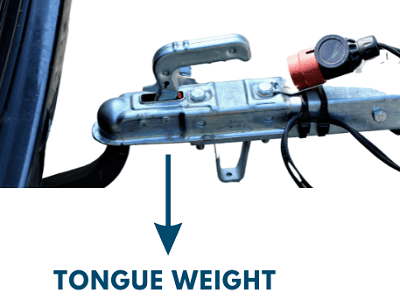
Tongue weight represents the vertical force exerted by the trailer’s tongue on the towing vehicle’s hitch or coupler. You need to calculate your exact trailer tongue weight range in pounds. Make sure you only add that much to avoid unnecessary swaying and keep your trailering smooth and safe every time.
That’s when knowing your trailer’s GTW becomes important. Because you only need to get 10% to 15% of the GTW to figure out your tongue weight. For example, if your GTW is 5,000 pounds (trailer weight and all the load of the cargo combined), then that leaves you with a tongue weight range of 500 to 750 pounds.
Length and width relate to boat trailer ratings by making sure that the boat will be securely accommodated and transported by the trailer.
Trailer manufacturers carefully measure the width to ensure the boat will fit properly within the trailer’s frame. If the boat exceeds that width, it won’t be properly supported and will become unstable during transportation. Of course, such a setup only invites danger.
Likewise, the trailer’s height relates to vertical clearance. The boat’s height on the trailer should be accounted for to avoid potentially hitting bridges and overpasses, which again brings about a risky situation.
These are the variables that directly impact the boat trailer weights and their respective trailer ratings.
1. Boat Weight
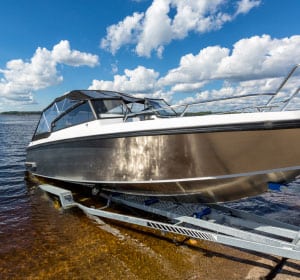
The fact that both the GTW and GVWR account for the boat’s weight clearly underscores its status as a crucial factor. Whatever your boat’s total load is, it shouldn’t exceed your trailer’s rating or be paired with a trailer that can safely carry its entire weight.
2. Trailer Type and Capacity
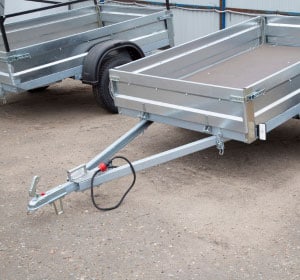
The type of trailer you’re using and its capacity influences ratings as well through the following facts:
- Boat trailers can be classified based on the type of boat they are designed for, and that already dictates their specific weight capacity.
- Double-axle trailers almost always have a higher maximum load limit (often three times more) than their single-axle counterparts.
The trailer capacity is readily displayed on the data plate. It relates more to the GAWR (Gross Axle Weight Rating), which can be used to calculate the GVWR. In a single-axle trailer, the GVWR and GAWR are the same.
The same can’t be said for a double-axle, though, as you’ll need to multiply the weight rating of each axle to get the GVWR. For example, if your GAWR is 1,500 pounds and you’re using a double-axle, the GVWR will likely be 3,000 pounds.
You also have to keep in mind that you have to deduct 12% from a double-axle trailer’s weight rating when calculating the load you’re going to put on it for added safety.
3. Towing Vehicle Capabilities
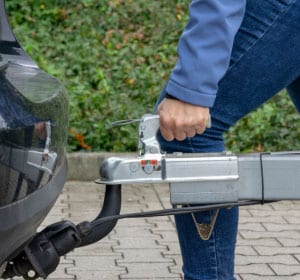
The towing vehicle is just as important in maintaining safe and efficient transportation. As such, its towing capacity should be matched with what the trailer is rated for.
Towing too much weight only leads to a difficult overall drive and can even put you and others on the road at needless risk.
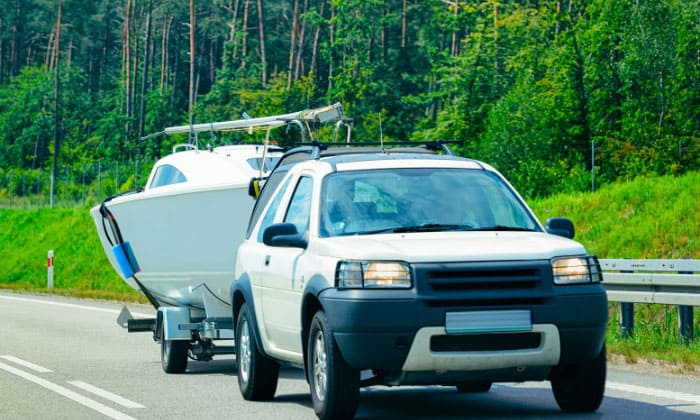
Importance of Boat Trailer Ratings?
Simply put, they provide you with the exact weights that you can only work with and adhere to every time you decide to go out trailering. They provide safety benchmarks that keep everyone on the road safe.
What happens if I exceed the trailer weight rating?
If you continue to ignore your trailer’s assigned weight rating, you’re essentially putting yourself in danger and aren’t doing your trailer and towing vehicle any good.
Also, chances are, the engine will require constant maintenance and repair due to the extra load you’re constantly putting on it. The trailer’s tires will also bear the brunt of the added weight, which only spells bad news.
It’s not for nothing that tire issues account for a majority of on-the-road boat accidents.
Can I upgrade the trailer to increase its capacity?
Yes, if the axle is the lowest-rated component, then feel free to add another one to boost the load limit. Moreover, you can also consider upgrading individual components such as the shock absorbers, lead springs, and coil springs.
Consider higher-quality materials for your axles, particularly those made of zinc or galvanized steel, to boost their reliability and longevity.
Are there different ratings for different types of boats?
Yes, as a reference, refer to a weight chart found online or any local resource you may come across. On the whole, jet ski and canoe trailers will have lower ratings than trailers designed to carry fishing vessels and larger watercraft in general.
Boat owners who ask, “Trailer ratings are based on what?” should always remember the myriad factors shared here and seek to know more about trailering because it will always be intertwined with their activities, one way or another.
Everything you put on your trailer relates to GTW, GVWR, tongue weight, and GAWR. These are the parameters that stand out the most in this discussion, which is only proven by their prominence in trailer data plates and discussions about trailering as a whole.

“My intention from the first day establishing Boating Basics Online is to provide as much help as possible for boaters who want to experience a first safe and convenient trip. So feel free to join us and share your beautiful journeys to the sea!”
- Account Settings
2004 Airstream Land Yacht Review
I had a chance to take a Land Yacht on the road for several days and I decided that I’d do my best to look at this Class A with new eyes. Forget the Airstream history and influence and take this vehicle at face value. I think I’ve succeeded; certainly being able to spend five days in the unit helped, plus the 600 miles I put on the odometer. Still, my first impression is that this is a very different RV.
Airstream launched its first motorhome in 1979, a unit that pretty much mimicked the classic riveted aluminum body of its trailers. The Land Yacht, however, rolled out in 1989 and came with laminated fiberglass construction; a look that was much more traditional Class A. For 2004, it’s available in four floorplans from 26 to 33 feet in length. I tested the 30-footer with the only slideout in the bunch.
Built on a Workhorse gas engine chassis the Land Yacht is smaller than what its price might lead you to believe it should be. It’s also shorter and a little narrower than other Class As. But inside the quality of the fixtures and the artistic design accents hint at this Airstream’s target market; established and upscale. Another hint has to do with plenty of features that are standard on a Land Yacht but are optional on other makes. Overall though the best description of this unit is found in the company’s brochure; it says “The answer for those who want the spaciousness of a larger motorhome with the mobility of a smaller unit.” Currently I still have two teenage boys at home and when we travel a mule-train’s worth of stuff goes with us, so my initial impression was “why, would I want a smaller RV?”
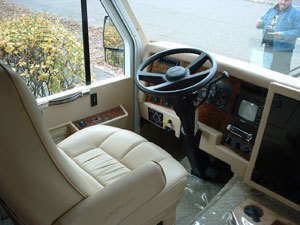
The answer to that question (in part at least) is the on-road manners of the Land Yacht. First the lower profile of the unit reduces the hi-centered sway that some taller units suffer from and the relatively short length eliminates front-end bounce on uneven pavement. The 8.1 L gas engine, pulling this weight, is very strong with ample low-end torque and it cruises easily at (or over) the highway speed limit. With the cruise control set, the coach required a minimum of attention, it felt good, moved easily through traffic and its mirrors and windows afforded good sightlines. I enjoyed my drive of several uninterrupted hours – no white knuckling with this unit. I even found that vacuums and cross winds from passing trucks and bridges had no effect on the unit. My only criticism would be about a small amount of wander in the front end, which required me to work the steering more than I thought was necessary.
A nice feature on the Workhorse is a digital information centre on the dash that includes an instant fuel consumption figure. I noted that it read roughly 9 mpg at roughly 70 mph or 10.7 mpg at 62 mph; figures that I considered reasonable to good.
Its low aerodynamic shape with a split windshield that sits at a 40 degree angle no doubt contributes to its fuel mileage. The driving area is elegant with leather seats (fully powered and reclining) and hardwood accents. The instrument panel is well laid out with easy to read switches, including a generator start switch, front fan controls and the hydraulic leveler touchpad. The driver’s door has a power lock and window.
An in-dash backup camera can be swiveled with the touch of a button to point the camera down for backing in or swiveled up to watch following traffic on the highway. In addition, because the Land Yacht has a rear window over the bed, there is a clear line of sight via the rearview mirror to the back of the unit.
In the salon the brocade material on the foldout couch, in the slideout, is rich as is the carpeting, window treatments and cabinets.

The dinette table, just inside the door, has an expandable leaf, and there are two extra folding hardwood chairs in the hanging garment closet.
A key feature in the coach is the unique round sink. It defines the centre of the coach and creates a visual break between the kitchen and salon. The sink has a cover that doubles as counter space. Below it are pair of cupboard doors that match the curve of the sink and countertop – very elegant looking. The galley comes with a three-burner range with cover, exhaust hood, a convection microwave oven, oak cabinetry, Corian countertops and a residential style Moen faucet. The refrigerator is skinned in a bare steel look. Overhead there are two skylights, with shades, and there are also two Magic Fans that open and close automatically.
Lighting in the coach is a mix of recessed fluorescent fixtures and individual lights throughout. Many of these lamps can be aimed and with separate switches on each you can have as little or as much light as you need. The bedside lamps in particular are nice.
There are two AC units, both roof mounted low-profile types. One is dedicated to the bedroom, the best place to have air conditioning. The furnace is one centrally located heating unit. During my late fall excursion I had the heater running constantly. Temperatures dipped well below freezing at night and hovered just over it during the day. The system (run off a main thermostat) worked just fine and had no trouble keeping the coach warm. Over the course of five days I went through only about half of the 90 lb of propane on board. It helps that the Land Yacht features a rear automotive heater that really pumps the heat into the coach while you’re driving.
A 20-inch LCD flat screen TV mounted in the main salon with a multi-position swingarm is not only a space saving idea, but the variations in positioning means it can be watched from the table, couch, front seats or even while working in the kitchen. A smaller 14-inch TV in the bedroom can be tuned to different channels or a video signal if your viewing tastes differ from those of your guests. Headphone plug-in over the queen-size bed allows silent viewing or can be switched to listen to the radio.

The bathroom area layout has the full-size shower with glass door on one side of the hallway and the toilet and vanity on the other side (with its own door). If you leave this door open you have a spacious bath and change area open to the rear bedroom. If you choose you can also close the sliding pocket door from the bedroom and have complete privacy.
Interior storage on the Land Yacht is adequate, but outside the low-profile construction of this RV makes the basement section small and narrow. For instance a standard milk crate won’t go through the side compartment door. At the rear, under the window, there is a so-called “trunk”. This is the largest storage space access on the coach. At almost waist height it’s handy for getting things in and out of, but I found that the barrel and pin latch system it uses kept sticking. It’ll need lubrication from time to time.
A large part of the Land Yacht’s appeal is its unique shape, paint schemes and reflective tinted glass. In addition to the two-tone paint, it sports polished reverse chrome bud wheels – even the rooftop mechanicals are color co-coordinated.
If you are thinking of a nice two-person coach; something a bit smaller yet unique and rich, the Land Yacht is worth a look.
Popular Article
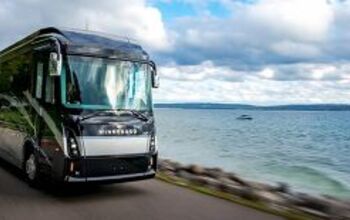
Enhanced Online Shopping Tools Now Offered by Winnebago
You may also be interested in.
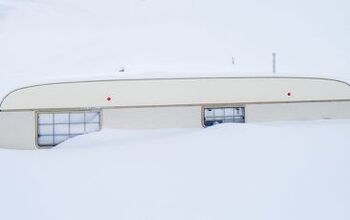
RV Winter Storage: Shrink Wrap Vs. Tarp
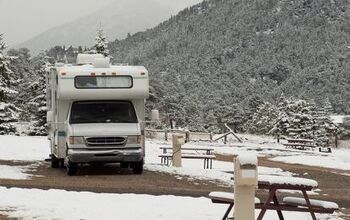
How To Choose the Best RV Heater For Your Needs

Three Fixes for a Leaky RV Roof
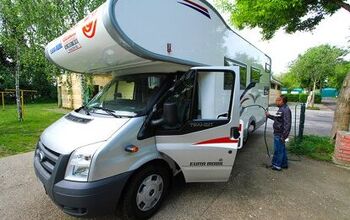
How To Sell Your RV
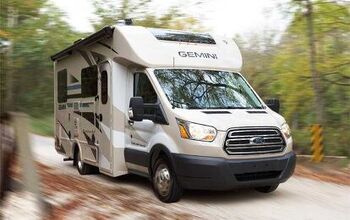
Everything You Need to Know About RV Rental
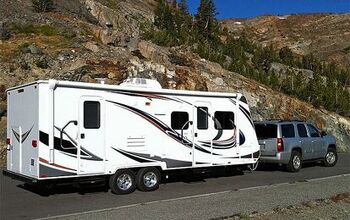
Five Summer RV Destinations You Shouldn’t Miss
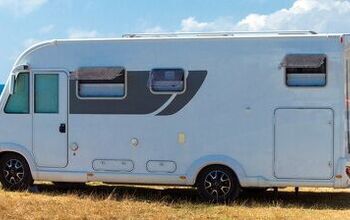
RV Blinds and Window Shades Buyer’s Guide

Six Secrets to Hosting the Ultimate RV Tailgate Party

10 Reasons to Never Own an RV

How to Buy a Used Motorhome

How to Find the Best RV for the Money
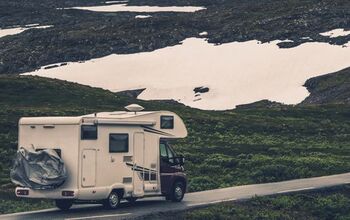
How To Maintain Your RV Furnace
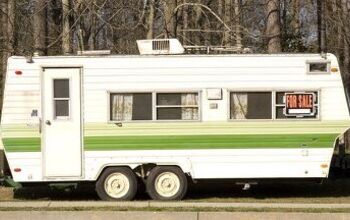
Should You Buy a Used RV?

What To Do If You Get Your RV Stuck
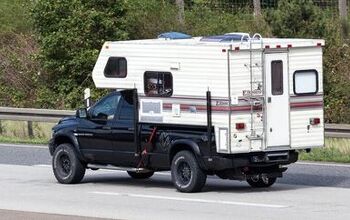
How To Pick the Right Truck Camper
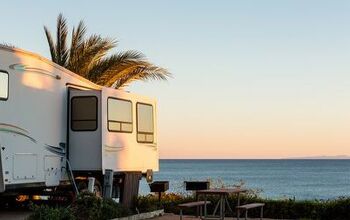
A Beginner’s Guide to RVing
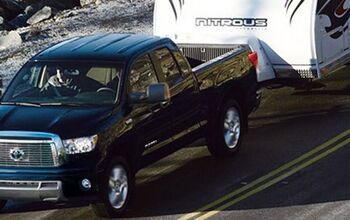
How to Pick the Right Tow Vehicle

Five Maintenance Tips for Your RV

IMAGES
VIDEO
COMMENTS
You can get a trailer down a boat ramp, it stores for free in your backyard, and it has many of the benefits of a keel boat or dinghy, with fewer drawbacks. Some might argue that the perfect sailboat is the trailer sailer. ... Reviews & Ratings. Daniel Wade. September 26, 2023.
2. Gallery. 2 Images. C-Dory 25 Classic Cruisers ROSBOROUGH RF-246 Digby ROSBOROUGH Atlas Acadia 25 Eastern Boats PARKER 2530 XLD Sport Cabin EASTERN BOATS 248 C-Dory RANGER TUG R-23 Parker Trailerable Trawlers Ranger Tugs. Outboard-powered trailerable cruisers give owners the freedom to pick up and go from coast to coast.
The Voyager 20 measures in at 19ft 10in overall, with a trailer-friendly beam of 7ft 6in, and its base price is $29,995. Pulse 600. Speaking of trailer-friendly, nothing else comes with as potent a blend of portability and punch as a trailerable trimaran. Alliteration aside, Corsair Marine's new Pulse 600 looks like an extremely enjoyable ride.
New Zealand Trailer Yacht Ratings Current from July 2023 Boat Type NZTYA Rating SRI Division (recommended) Minimum Motor Size (HP) Clarification check to Rule 13 YNZ Safety Regulations Part V Thompson 8m 1.090 1.720 A 6.6 Cook 10m (Provisional) 1.050 A 8.2 Shaw 750 ty (T4251) (Provisional) 1.050 A 6.2 Thompson 650 1.043 A 5.3 Shaw 750 (T9255 ...
Reality may well see the boat weighing more. "Steel-built trailers typically weigh about 40% of the weight of the boat they carry, suggesting you're looking at towing something like 1,750kg, perilously close to the 1,800kg limit for a single axle trailer. "However, having personally towed a similar weight for many thousands of miles ...
A handicapping system thus allows the smaller boats to compete on an equal footing and take home some of the silverware. There is also a national NZTYA Rating system for trailer yachts (see above) that sorts the relative performance of all trailer yacht types in NZ. Yachts of the same type are on the same handicap number when the national ...
2) West Wight Potter 19. jacqeast. We thought it fitting to include the Potter 15's big brother, the West Wight Potter 19, on this list of the best trailerable sailboats. West Wight Potter boats are well known for their robust design and easy handling, and the Potter 19 is no exception. The West Wight Potter 19 boasts the seaworthiness and ...
The new Rating System is intended to: • Provide a National System for even and fair racing on handicap in a mixed fleet of Trailable Yachts and / or Sports Boats. • Ensure transparency across the rating system. • Allow Trailable Yacht and Sports Boat owners to gain a new CBH at any time of the year. • Support Australian Sailing in its ...
A custom trailer is available, and the boat can be powered with an outboard or an optional Cummins MerCruiser Diesel 150hp I/O. Cruising speeds from 15 to 20 knots are typical, depending on the engine power and equipment specified. Learn more at www.aerocat boats.com, or call Terry at 814.602.9286.
LATEST NZTYA Ratings are now available on the website here The major change is the suggested make up of the 3 Divisions A Division - boats rated above .889 B Division - boats rated from .820 to .888 C Division - boats rated up to .819 ... TRAILER YACHT DESIGNS SAFETY SRI TESTS NEWS Folder: EVENTS & RESULTS. Back. EVENT CALENDAR RESULTS ROLL OF ...
Com-Pac's range of trailer sailers with accommodations starts with the 16-feet 6-inch Legacy, an entry-level trailer sailer that can sleep a couple plus a small child or two, but is otherwise devoid of amenities, and moves up through the 21-feet Eclipse, the CP23 Pilothouse and the 23/IV. Aside from their well-thought-out rig-raising systems ...
Ratings as Approved at the 2021 Annual Meeting of Representatives including Mark Foy Handicapping and Handicapping Trailer Yachts at the Club Level. LEARN MORE. Trailer Yacht Designs. The NZTYA has approved over 160 Trailer Yacht designs. Many of these have been reviewed. Listed here are links to copies of the reviews. LEARN MORE. Safety.
Farrier, who passed away in 2017, created the F-22 as a kind of culmination of all he'd continued to learn about small, trailerable multihulls in the years since he penned the F-27 trimaran, a true trail-blazer and now part of the "Sailboat Hall of Fame.". Another F-22 sidles up alongside a pier in Malta with amas folded in.
Though not a true launch-and-sail trailer sailer, a four-by-four will still be able to tow the 32 on her own trailer, as boat and trailer come in at under 3.5 tonnes, and within the 2.9m overhang limit. With a keel-down draught of 2.8m, a fine entry at the bow and broad aft sections, this boat promises to be a good performer.
The Garmin EchoMap Ultra 2 Series: Advanced & Affordable. The EchoMap Ultra 2 is an advanced yet affordable chart-plotter display suited for freshwater and nearshore boating anglers. Boating, with its heavy emphasis on boat reviews and DIY maintenance, is the most trusted source of boating information on the web.
The cost of a boat trailer can range from $500 to over $10,000. The price depends on the materials, size, carrying weight, and design. We are going to give some examples of different types of common boat trailers. Single-Axle Boat Trailer Cost. A single-axle boat trailer can cost anywhere from $700 to over $4,000.
The NZTYA has approved over 160 Trailer Yacht designs. Many of these have been reviewed. Listed below are links to copies of the reviews. This is not a complete list, if you are aware of one we don't have, or have a copy of a manufacturer's brochure we would like to know so we can add it to this collection. Please contact the NZTYA ...
Whether you're a seasoned RV enthusiast, a boat trailer owner, or are venturing into the world of hauling cargo, understanding trailer ratings is essential. It's not just a matter of hitching your trailer and hitting the road; you need to be aware of your vehicle or boat's weight limitations, how to match the right trailer to your needs ...
A fishing boat trailer usually weighs 200 to 1,100 pounds on its own, without a boat loaded. The average for a boat trailer is about 600 pounds. Combined boat and trailer weight ratings ranges from 900 to 6,000 pounds, depending on the length of the trailer and the boat itself.
1. You do need a way to attach the trailer to your tow vehicle. The best way to do this is to utilize a ball tow hitch and a coupler. The coupler on the trailer will attach to the ball hitch that is on the tow vehicle. On the coupler is a lever that holds a cotter pin and a hole.
The NZTYA assists Squadrons, Clubs and Trailer Yacht Sections of Clubs and Class Associations to coordinate Trailer Yachting within their respective memberships. These can include National and intra Island championship events, where owners of many types of trailer yachts can meet and enjoy competition based on our national handicap/rating system.
Trailers are mainly rated based on their gross trailer weight rating (GTWR), tongue weight, as well as the trailer's length and width. Other factors that influence it are the boat's weight, trailer type and capacity, and the towing vehicle's capabilities. Table of Contents [ hide] Evaluation Criteria for Trailer Ratings. 1.
Airstream launched its first motorhome in 1979, a unit that pretty much mimicked the classic riveted aluminum body of its trailers. The Land Yacht, however, rolled out in 1989 and came with laminated fiberglass construction; a look that was much more traditional Class A. For 2004, it's available in four floorplans from 26 to 33 feet in length.